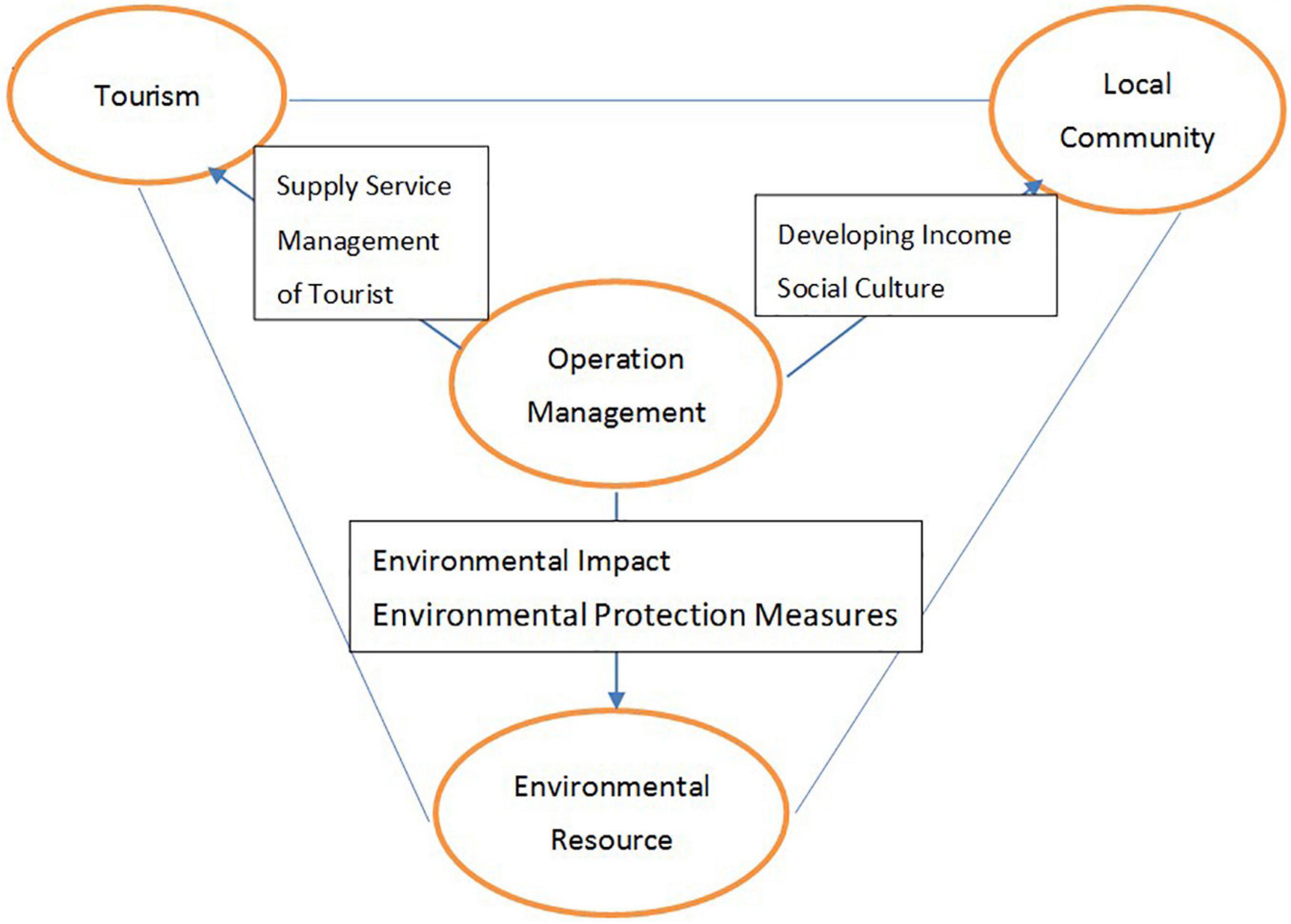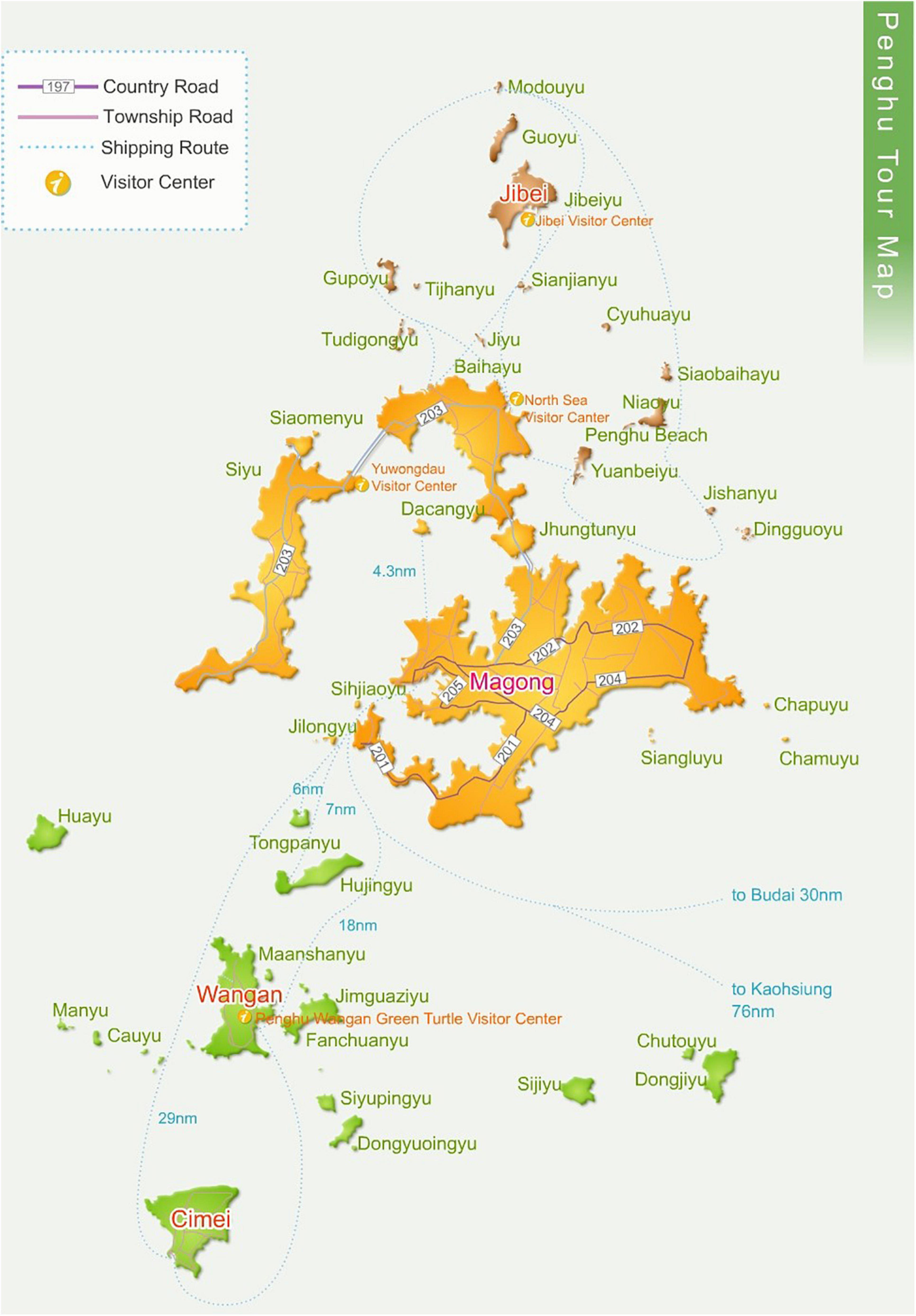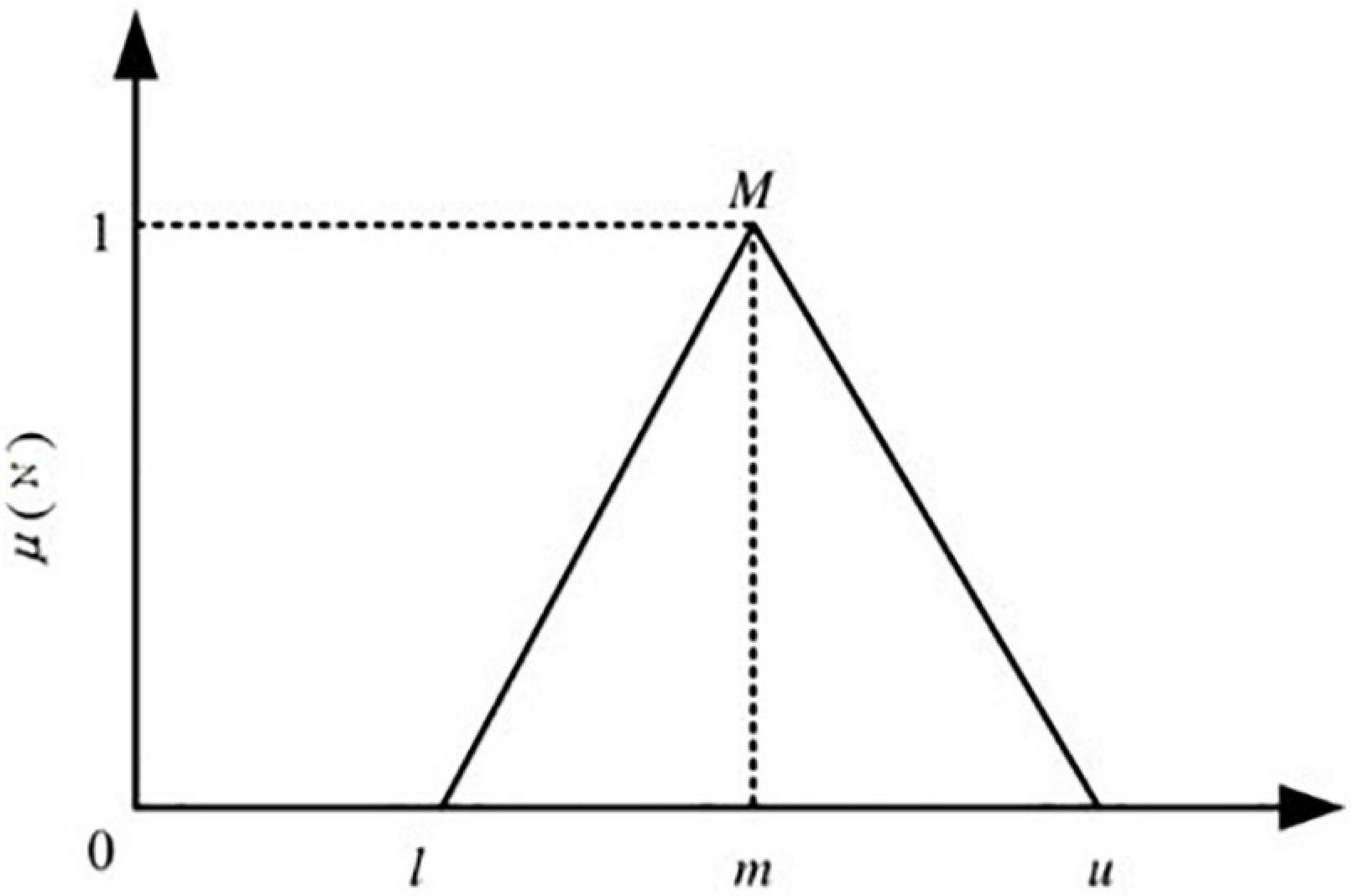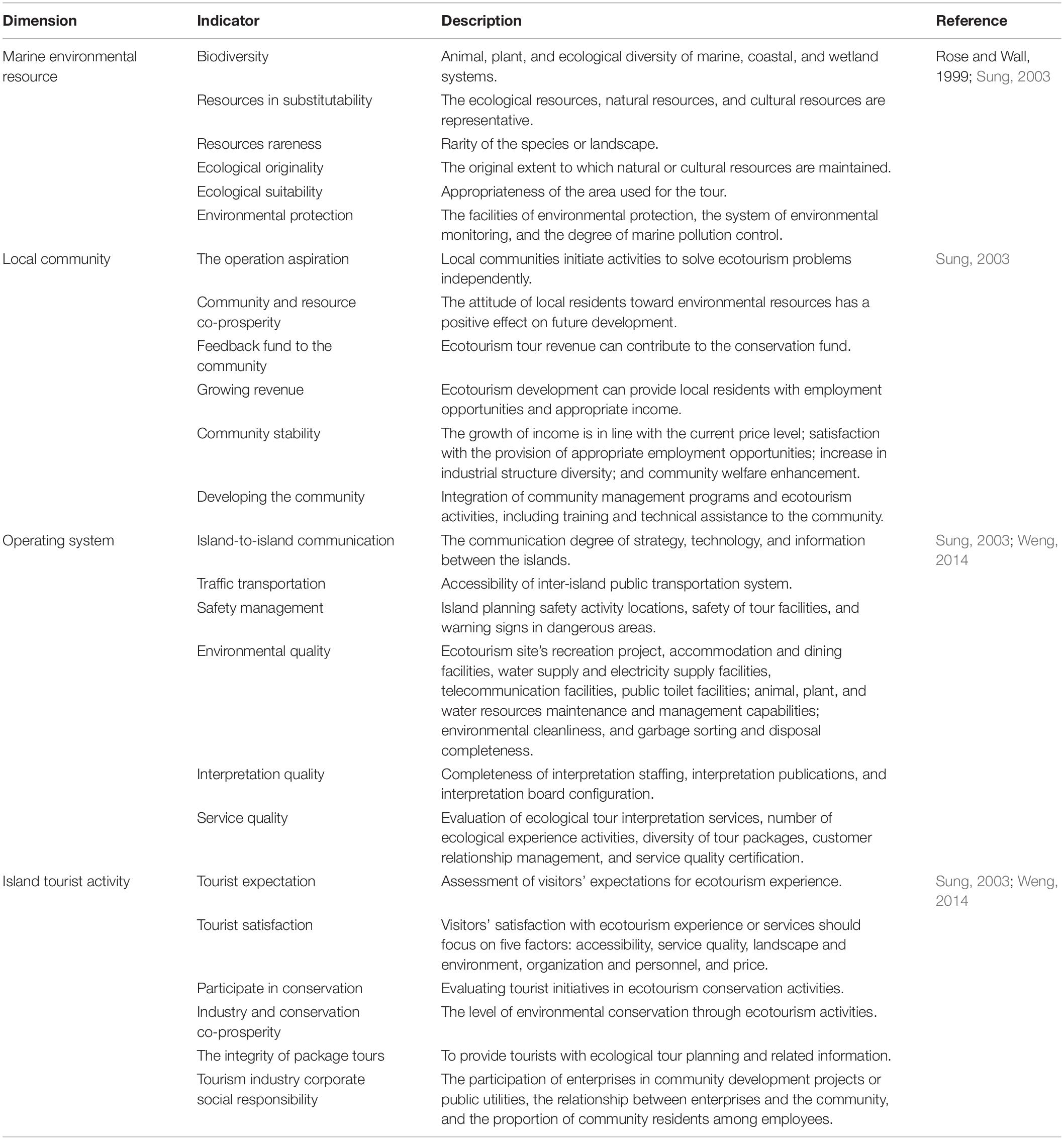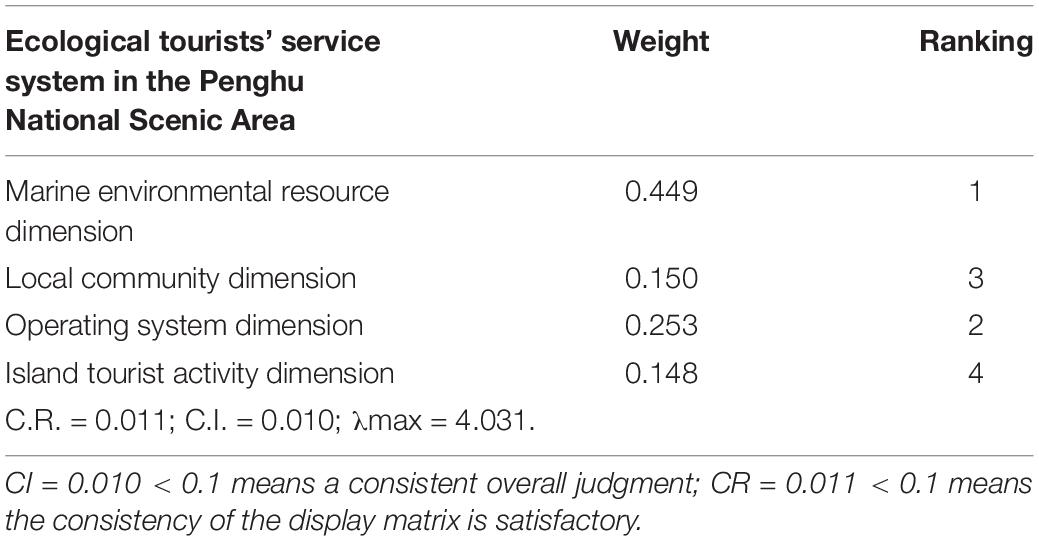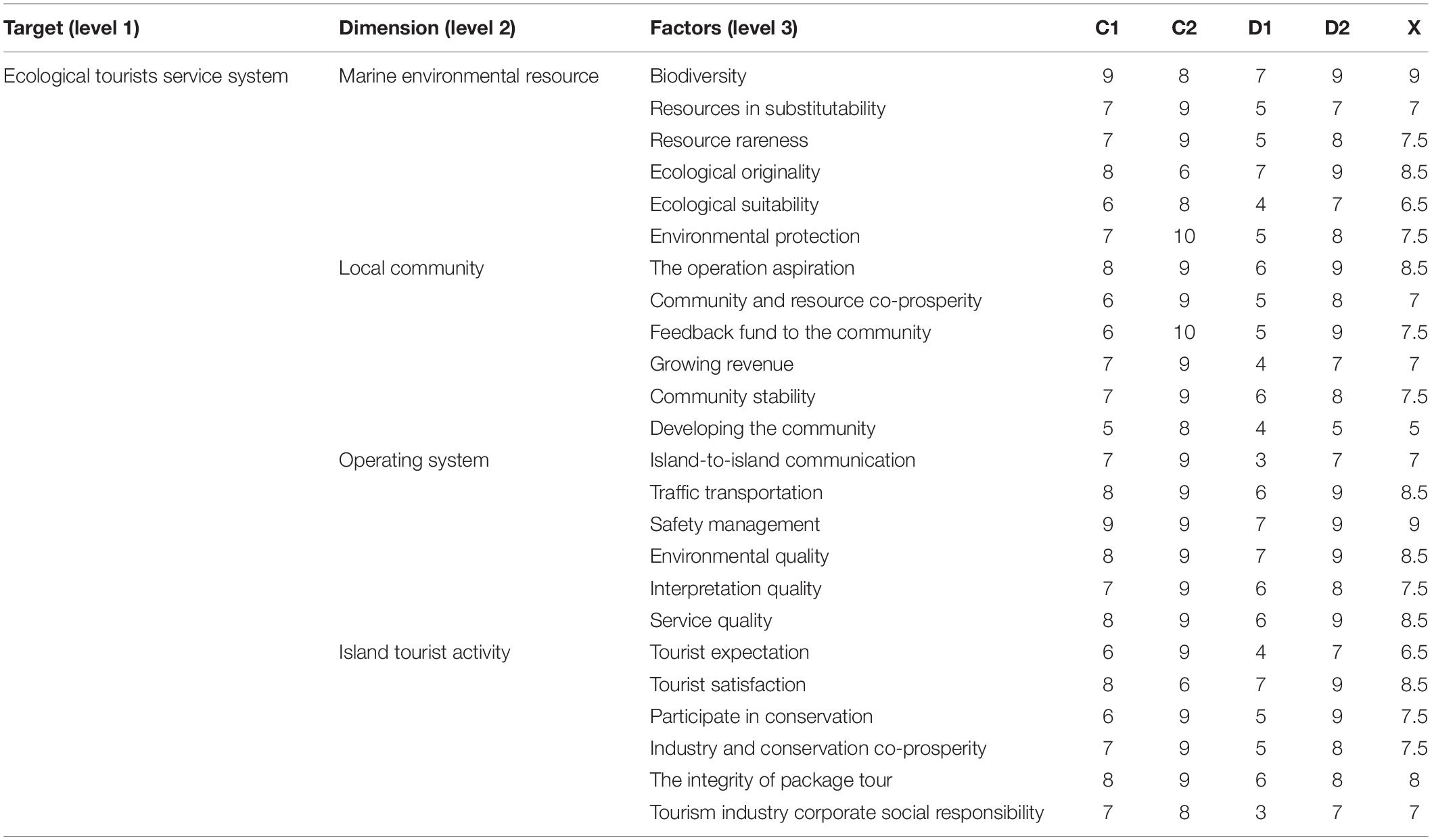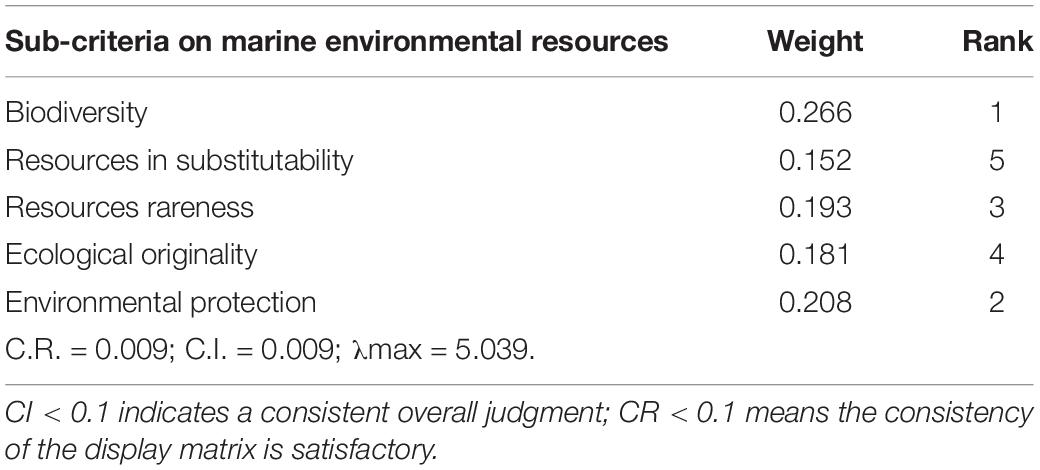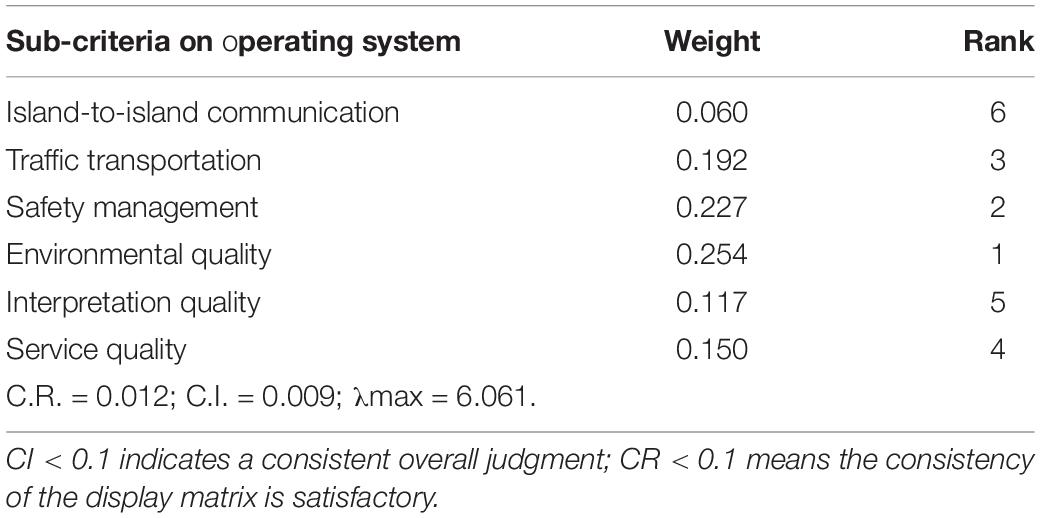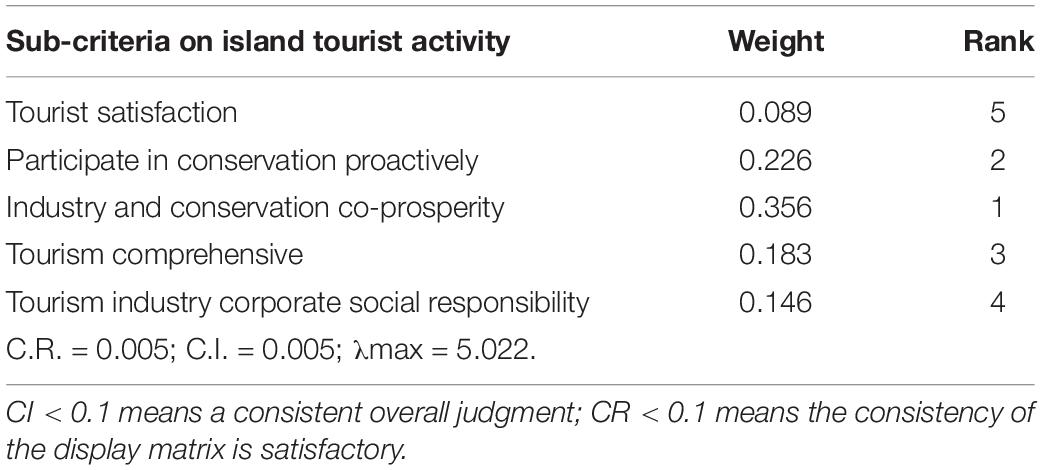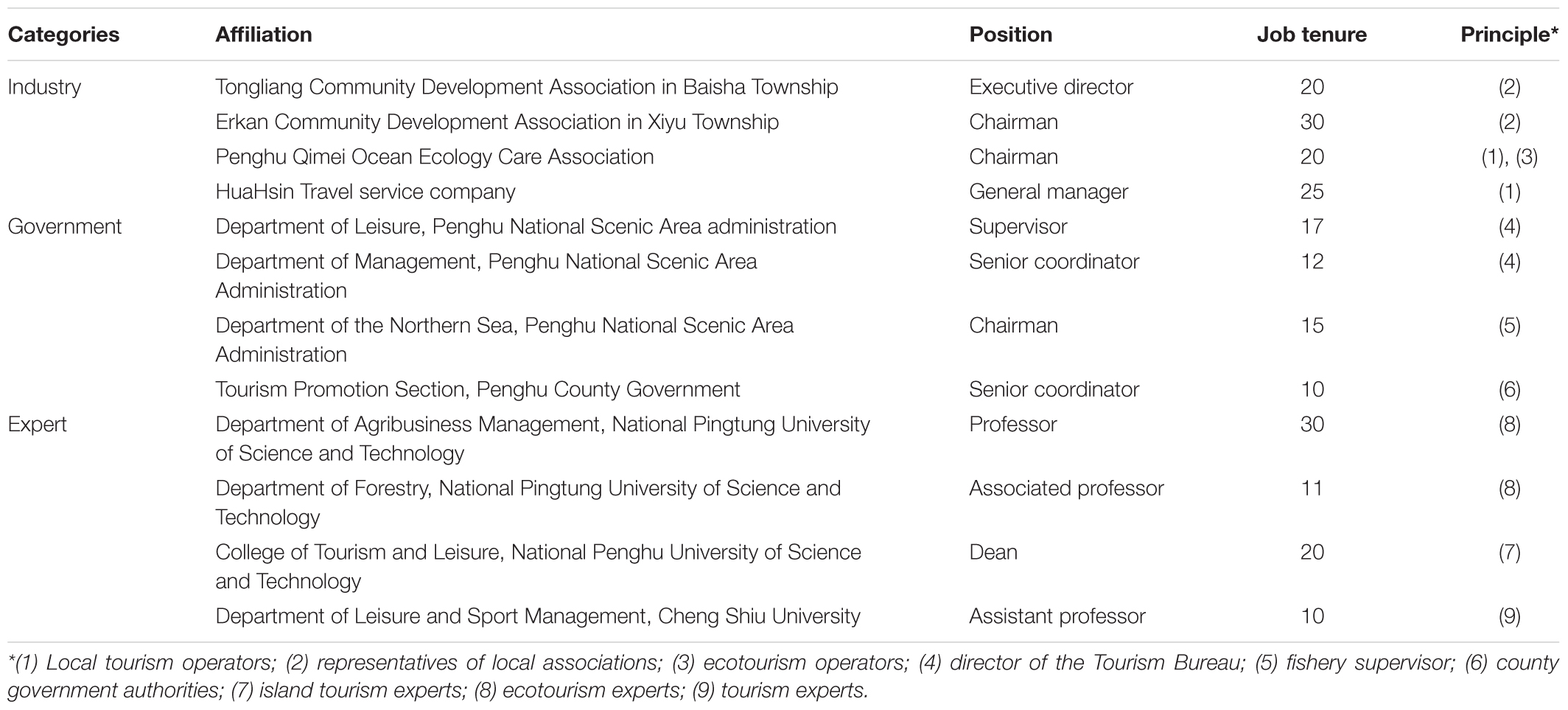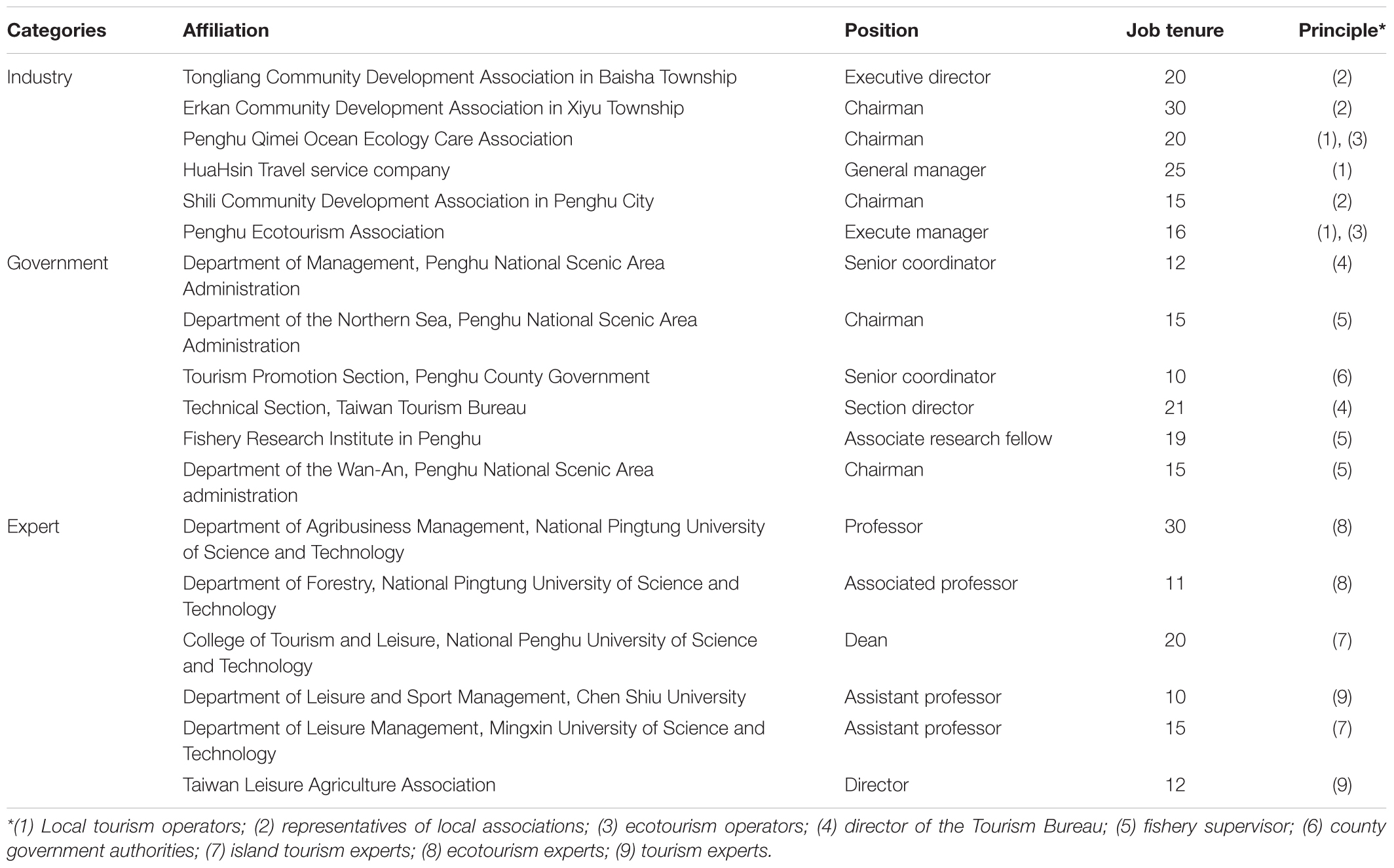- 1Department of Tropical Agriculture and International Cooperation, National Pingtung University of Science and Technology, Pingtung, Taiwan
- 2Department of Leisure Industry Management, National Chin-Yi University of Technology, Taichung, Taiwan
- 3Department of Agribusiness Management, National Pingtung University of Science and Technology, Pingtung, Taiwan
It is critical to develop a sustainable ecotourism service system for the fragile Penghu National Scenic Area in Taiwan. This study, therefore, adopted the fuzzy Delphi method and analytic hierarchy process (AHP) to establish an index framework. The results identified four dimensions with 21 service factors. The findings are as follows. Safety management capability is found to be the main factor in the ecotourism service system. Ecological diversity is essential for the marine environment and the core resource for ecotourism; the transportation capacity and environmental quality need to be improved. Marine environmental resources are indispensable to the development of ecotourism. In addition, the local community must support ecotourism, natural resources should be protected, and the development of ecotourism needs to support the sustainability of local conservation. Therefore, encouraging local residents and stakeholders to attend and promote ecotourism, establishing a safety management system for ecotourism, developing environmental protection regulations for tourists in ecotourism, and improving tourist satisfaction are vital. The government needs to develop guidelines for the protection of marine resources, plan an ecotourism service system, and improve public and transportation infrastructure to make it safe and accessible.
Introduction
Tourism, local resources, the environment, and residents have a close relationship with each other. Tourism development is a catalyst for economic growth in island regions in developing countries (Buultjens et al., 2017). According to the United Nations World Tourism Organization (UNWTO), in 2013, 40.83 million tourists stayed overnight on islands, and generated USD 5.3148 million in revenue (United Nations World Tourism Organization, 2014). Island tourism has an essential role in economic development. However, island tourism has environmental consequences (Sundra, 2011). It has dried up coral reefs (Kurniawan et al., 2019) and collapsed the seagrass ecosystem (Cullen-Unsworth et al., 2014). Therefore, the concept of sustainable tourism should apply to islands.
Ecotourism is a travel style of sustainable tourism, which is a growing development trend of recent years, contributing to the jobs and revenue for the local community, conservation, and preservation of such areas (Page and Dowling, 2002; United Nations World Tourism Organization (UNWTO), 2018). Local residents can use the ecological and cultural heritage resource to provide experience and learning activities for tourists in the area (Tuan, 2016). According to the UNWTO forecast, an estimated 1.8 billion tourists around the world wish to be sustainable tourists (United Nations World Tourism Organization (UNWTO), 2018). Meanwhile, tourists’ demands are changing to include new traveling styles, such as agritourism, ecotourism, and green tourism.
Thus, the tourism industry needs to adapt to tourists’ expectations while protecting natural resources (Blancas et al., 2015). There are many elements of ecotourism to consider, depending on the quality of the natural resources, cultural heritage, and biodiversity. The community should have an awareness of the environment and cultural heritage (Shelly and Wall, 2001; Weaver and Lawton, 2007; Tuan, 2016). However, these elements raise concerns about nature and culture, environmental education, the understanding of environmental protection, the shared benefits for the community and stakeholders, and the relationship between the environment, society, economy, and tourists (Chen, 2015; Tuan, 2016; Chao and Chao, 2017; Ng et al., 2017). Consequently, for ecotourism to be sustainable, careful planning and management are necessary (Baral, 2015). In addition, it must meet tourists’ expectations, be connected with the local community, and effectively use local resources to achieve the goal of sustainable ecotourism development.
Recently, some scholars argued that the rapid growth of ecotourism is not sustainable, they suggested that ecotourism only caused slower resource degradation than mass tourism (Regmi and Walter, 2017). Some ecotourism sites are located in a fragile environment with less infrastructure (Butler, 1999). Too many tourists will damage the local environment and reduce income diversity (Honey, 2008; Weaver, 2001). In contrast, Gunter et al. (2017) argued that ecotourism-led growth has promoted comprehensive economic development. The sustainable development of ecotourism is needed to find the balance between environment and economy. Despite ecotourism’s important role, it is still inadequately defined so its guidelines are unclear (Sander, 2012).
Island ecotourism, which aims at sustainable development, is one way to develop the economy using the local community, tourist activities, and environmental resources. Some scholars discuss the sustainability of island ecotourism in terms of vulnerable island environments (Hall, 2012), environment destroyed by overtourism (Kuo and Chen, 2009), social and ecological resilience (Cheer et al., 2017), island governance (Luthe and Wyss, 2016), local residents’ attitude to tourism (Pennington-Gray et al., 2005), and entrepreneurship’s responsibility (Russell and Faulkner, 2004).
In early studies, Stem et al. (2003) defend sustainability as the key indicator that distinguished ecotourism from mass tourism. One popular way to examine the sustainability of ecotourism is to use measurable indicators to represent the functional characteristics of a system (Gallopín, 1996). Most indicators can provide sufficient information for decision-makers based on the type of action that has been implemented (Layke, 2009). Agyeiwaah et al. (2017) argue for sustainable tourism indicators on a case-by-case basis.
The coastline of the Penghu archipelago is 448 km long, and like other forms of ecotourism, it has been a primary source of revenue for Taiwan’s government. Many tourists still take multiple-day trips to the archipelago, even though transportation is limited. According to the Penghu government statistics, more than 1 million tourists visit every year. In this regard, the Taiwanese Tourism Bureau Republic of China (2018) announced Ecotourism Year. It offered 42 ecological package tours, including to Penghu. However, although tourism can increase island revenue, it can also damage its marine resources.
There are many studies of ecotourism in the Penghu archipelago. Liang and Tsai (2008) studied 364 ecotourists, and the effect of their activities on their intention to revisit. Hsieh et al. (2016) compared the attitudes of residents and tourists and pointed out that positive economic and cultural resources will upgrade tourism development. Chao and Chao (2017) argue that the visitors to the Wang-An Islands need to enhance environmental concerns of visitors, and have carefully managed “deep experience” activities and small-scale tours. At the same time, the residents need to acquire the environmental knowledge to become de facto interpreters for the visitors. According to Yu et al. (2015), communities need to protect their environmental resources and promote the willingness of tourists’ impressions. Wu and Tsai (2015) pointed out that the local community is the crucial element for tourists’ activities in the Penghu National Scenic Area. Thus, most of the literature discusses ecotourism development from just one perspective instead of from several.
Ecotourism requires interaction between residents and tourists. The residents take advantage of environmental features and design experience activities for attracting tourists to increase income (Wu and Tsai, 2015; Tuan, 2016; Chao and Chao, 2017). While reviewing the previous studies on the Penghu National Scenic Area, we can see that they focus on revisit intention (Liang and Tsai, 2008), tourism development in resident and tourist attitude (Hsieh et al., 2016), experience activities (Chao and Chao, 2017), and resident operating intention (Wu and Tsai, 2015), rather than discussing the service system and combining ecotourism and service indicators. The purpose of this article is to construct a sustainability and service system to maintain the Penghu National Scenic Area.
The United Nations Commission on Sustainable Development (UNCSD) has recognized the use of criteria and indicators in measuring sustainable development. The sets of criteria and indicators are used to track all changes at ecotourism destinations. These sets can explain whether destination tourism is improving or deteriorating (Tsaur et al., 2006). Since various indicators of ecotourism must be considered in the evaluation process, a multi-criteria decision-making (MCDM) method is proposed. In addition, to solve the uncertainty related to data collection and judgment elicitation in the MCDM method, the evaluation process uses the fuzzy set theory (Zadeh, 1965). The fuzzy Delphi method (FDM) is used to classify sustainable tourism indicators.
This article describes marine ecological resources, local community, operating system, and tourist activities in the Penghu National Scenic Area, then discusses each criterion and indicator of the ecotourism service system.
Literature Review
Sustainability in Island Tourism
Islands attract tourists because of their high scenic value, exotic wildlife, and culture (Hall, 2010). Tourists can enjoy a sense of freedom, a peaceful environment, and unique cuisine (Sharpley, 2015). In developing countries, income from island tourism is a very important source of revenue (Kurniawan et al., 2019). Island tourism creates jobs for residents and contributes to economic development (Cheng et al., 2013; Kurniawan et al., 2019). However, island resources and environments are very fragile (Douglas, 2006), and those limited resources are vulnerable to environmental damage (Lovelock et al., 2010) from tourism development (Cullen-Unsworth et al., 2014; Kurniawan et al., 2019). Therefore, the discussion of resources, environment, and tourism activities have been an important management issue for island tourism development (Kurniawan et al., 2017, 2019; Mai and Smith, 2018).
Early studies of island tourism have mostly explored its development and sustainability. For example, Mai and Smith (2015) measured sustainable tourism using a system dynamics model with indicators of tourist numbers, investment, tourism infrastructure, waste, pollution, and attractiveness. Ng et al. (2017) assessed sustainable tourism on islands using the Sustainable Ecotourism Indicator System (SEIS). The SEIS has three dimensions (social, environmental, and economic) which are interdependent on communities, tourism, and resources. The resilience of island tourism is discussed by disentangling resources and environmental and social dimensions from the social-ecological system. For example, Becken and Khazai (2017) discussed the role of tourism in assisting post-disaster recovery and the resilience of coral reefs in tropical regions (Phillips, 2015).
There are multiple perspectives on the sustainability of island tourism. The theories can be resource-based (McKercher, 1993), activity-based (Carlsen and Butler, 2011), or community-based (Hughes, 1995). However, there are no ecotourism indicators in the literature. To fill this gap, it is necessary to use Penghu to construct indicators for the sustainable development of island ecotourism.
Ecotourism and Sustainability
Ecotourism is a sustainable and responsible way of engaging and encouraging tourists’ behavior. It protects the biodiversity, natural environment, and historical and cultural heritage. Tourists can learn to strengthen protection of the environment and ecological resources (Lin, 2008). Miller and Kaae (1993) argued that there are two types of ecotourism based on a responsible traveling continuum. The purpose of passive tourism is to reduce environmental impacts while providing tourists with subjective experiences. In contrast, active ecotourism limits activities with negative environmental impacts and instead focuses on environmental ethics. There is a need to develop and manage activities that protect the cultural and natural resources of a site (Blancas et al., 2015). To reduce environmental impact and enhance ecological efficiency, local ecological resources and tourist activities need to be considered. For the most part, the local community or residents have been neglected in evaluations of ecotourism development (Mathis and Rose, 2016; Thompson et al., 2018). However, some practices have considered the factors of the local community on ecotourism development (Gezon, 2014; Hunt et al., 2015). Das and Chatterjee (2015) argue that local communities often receive low net benefits, and sometimes suffer from ecotourism.
Sustainable development is defined as “meeting the needs of the present without compromising the ability of future generations to meet their own needs” (World Commission on Environment and Development, 1987). The UNWTO defines sustainable tourism as “meeting the needs of present tourists and host regions while protecting and enhancing opportunities for the future.” It envisages the process as “leading to management of all resources in such a way that economic, social, and aesthetic needs can be fulfilled while maintaining cultural integrity, essential ecological processes, biological diversity, and life support systems” (United Nations World Tourism Organization, 2004). Sustainable tourism involves agritourism, green tourism, and ecotourism, and has to be determined by the economic, social, community, cultural, environmental, and institutional perspectives, to achieve long-term cooperation among stakeholders in protecting the ecosystem while promoting tourism (United Nations World Tourism Organization, 2015). United Nations World Tourism Organization (2017) declared the International Year of Sustainable Tourism for Development in 2017, suggesting 17 indicators for sustainable development, plus sustainable development goals (SDGs), to assist in evaluating sustainable ecotourism across five categories: inclusive and sustainable economic growth; social inclusiveness, employment and poverty reduction; resource efficiency, environmental protection, and climate change; cultural values, diversity, and heritage; and mutual understanding, peace, and security.
Despite the popularity of indicator building and the growing interest in sustainable ecotourism, there have been few studies. In the field of island ecotourism, these studies include Wang et al. (2016) on Taiwan coastal areas; Bhuiyan et al. (2016) on Kenyatta Lake, Malaysia; and Ng et al. (2017) on Tioman Island, Malaysia. Sustainable ecotourism indicators are limited by geographical location. As noted by Ocampo et al. (2018), the construction of such indicators is strongly correlated with the case study and its geopolitical, climatic, cultural, and social conditions (Ocampo et al., 2018). A review of more than 2,500 ecotourism studies by Liu and Li (2020) shows that the construction of indicators for case studies is rapidly growing.
Marsh (1993) listed four indicators to evaluate ecotourism criteria: ecology, society, economy, and regulation. Ross and Wall (1999) used these indicators to construct ecotourism criteria for tourists, the local community, and ecological resources, to evaluate the North Sulawesi Scenic Area in Indonesia and Amazonas in Brazil. Sung (2003) used operation management, local community, environmental resources, and tourism to construct an ecotourism indicator (Figure 1).
Sung (2003) argued that ecotourism development needs the cooperation of government, the residents, and tourists. Residents need to support ecotourism in terms of operating intention, attitude, resource utilization, and feedback. Tourism is the scope of the interaction between tourists and residents, and environmental conservation. The local organization can manage transportation safety, the interpretation system, communication with the residents, protection of environmental resources, and improvement of service quality. Thus, this article applies Sung’s (2003) indicators.
Service System
To meet tourists’ expectations, service quality is significant. The service system should meet the tourists’ demands. The service systems focus on the customer, activities, environment, technology, labor, and organization (Glynn and Barnes, 1995; Chen, 2010). Hornoiu et al. (2009) argued that three objectives are required to upgrade the quality of ecotourism services: environment, economy, and society; service quality and labor training; and tourists’ safety protection and information safety. The four indicators are the reduction of environmental resources, prevention of social and cultural collapse, the wise use of local resources, and quality management of ecotourism.
Weng (2014) lists eight management indicators to improve the ecotourism service system:
Organization: to promote ecotourism planning, business management, environmental education, and ecotourism.
Transportation: to maintain the road and trail system.
Resource: to protect biological and water resources.
Facilities: to maintain the infrastructure.
Environmental: to keep the environment clean.
Interpretation service: to host the interpretation location, to train interpreters.
Tourist safety: to ensure tourist safety.
Financial: to balance the budget and ensure the benefit to stakeholders and the community.
We constructed the service system of ecotourism in terms of institutions, the local community, environment, tourism industry, and tourist satisfaction.
This research combines the ecotourism system (Sung, 2003) and service system indicators (Weng, 2014) to construct the service system of ecotourism in the Penghu National Scenic Area. Hornoiu et al. (2009) considered improvement in service quality and tourist satisfaction in Romania, using four indicators: decreasing environmental pollution, improving the relationship with the local community, upgrading the environment, and enhancing the quality of management.
Methodology and Implications
Penghu Archipelago and Tourism
Island ecotourism is managed by the Penghu National Scenic Area. Penghu is Taiwan’s archipelago. It has received destination recognition for its island ecotourism, which utilizes the local natural resources of fish, sea turtle, coral reef, the intertidal zone, seashore plant ecology, migratory birds, and basalt cliffs (Chao and Chao, 2017; Penghu National Scenic Area Administration, 2018). From May 2003, the Penghu Fireworks Festival has been held by the Penghu County government and has become a magnet for tourists. According to the Penghu County Government Tourism Department, 1,326,216 tourists visited Penghu in 2018; of these, 63.56% engaged in ecotourism, including visiting the basalt cliff, intertidal zone, and learning about seashore plant ecology.
The Penghu archipelago has three ecotourism systems (Figure 2). Most of Magong’s residents have a strong Taiwanese culture. Magong is the economic, cultural, and political center of Penghu. The Northern ecotourism system consists of seven islands with fish, coral reefs, intertidal zones, seashore ecology, and migratory birds. The stone weirs are a famous destination. The Southern ten islands are home to fish, sea turtles, coral reefs, and basalt cliffs. The green sea turtle is an essential resource.
Numerous scholars discuss resources in the Penghu National Scenic Area, including tourists’ satisfaction of experience activities based on the sustainable perspective (Ni, 2000); experience activities (Hung, 2004; Wu, 2007; Chao and Chao, 2017); and tourism development viewpoints (Lin, 2002; Xue, 2002; Hu, 2009; Wu and Tsai, 2015; Hsieh et al., 2016).
Tourists learn about environmental conservation through educational activities. Some scholars have discussed customer behavior (Liang and Tsai, 2008) and marketing strategy (Hu, 2009). The objective of ecotourism is to balance environmental conservation with tourism (Chao and Chao, 2017; Tuan, 2019). With rapid tourism development, overtourism can reduce the quality of ecotourism and at worst, destroy the island’s ecosystem (Hillery et al., 2001; Wu et al., 2005; Chao and Chao, 2017; Ng et al., 2017). Thus, to sustain ecotourism development, an ecotourism service indicator system is important.
Fuzzy Delphi Method
The iterative Delphi method and non-parametric consensus measures were used to extract the final criteria and indicators set. The Delphi method is useful for seeking group consensus.
A comprehensive review of the methodology of the Delphi method has been conducted by Zartha Sossa et al. (2019). Although it has a wide range of applications, the field of tourism is more commonly used. In the absence of exact knowledge, San-Jose and Retolaza (2016) insisted that the Delphi method has the ability to compare individual mental maps of experts who integrate the data into future scenarios.
Although the Delphi method has considerable advantages, there is still uncertainty or ambiguity in surveys (Sackman, 1974). The shortcomings of the Delphi method include the time-consuming and costly collection of expert opinions, the low recall rate of questionnaires, the tendency to distort expert opinions, and the failure to take ambiguity into account.
Therefore, the FDM was developed to use the advantages of questionnaires and meetings (Linstone, 1978). The FDM theory developed by Zadeh (1965) can address situations where humans cannot precisely describe something. Fuzzy Delphi is used in team communication by gathering consensus and opinions through anonymous opinions. For instance, team members speak only to the researcher, not to each other. It avoids the distortion of expert opinions, capturing the semantic structure of predicted items, and considers the ambiguity of the data gathering and interview process (Lee and Hsieh, 2016).
To construct island ecotourism, it is necessary to set indicators. The island ecotourism indicator requires consideration of the key elements for all stakeholder groups in the Penghu National Scenic Area. These representatives need knowledge and experience to understand the ecotourism indicators. Dalkey and Helmer (1963) suggested that the group error can be minimized when there are at least 10 experts by implementing the FDM. A large number of experts may find it difficult to reach consensus (Brody, 2016). Delbecq et al. (1975) suggested 15–30 members for a high- homogeneity Delphi group and 5–10 for a heterogeneous Delphi group. Lee and Hsieh (2016) employed a Delphi survey in which 13 experts assessed 143 indicators to measure their importance.
The triangular fuzzy number (N), denoted as (l, m, and u), is one of the most commonly used fuzzy numbers. Figure 3 indicates (N). The parameters l, m, and u present the minimum, middle, and the maximum value, respectively. M represents the consensus. If the geometric mean of the factor is greater than or equal to the threshold value (M ≧ S), the factor is accepted as the evaluation factor; if not (M < S), the factor is deleted. If the decision-maker finds that there are too few factors, the threshold value (S) can be lowered; in contrast, the threshold value (S) can be raised. The membership function can be defined by Equation 1. The rest of the fuzzy set theory procedure is explained in the literature (Kim and Chung, 2013).
In constructing a service system of traveling into the Penghu National Scenic Area, no consensus has been reached as to how each indicator contributes to ecotourism in Penghu. Thus, to assess the indicator of the service system of traveling in Penghu, this article used a FDM to elicit expert feedback. This study followed Dalkey and Helmer’s (1963) suggestion, selected 12 members into three groups in the first round, and 18 members in the second to decrease group error.
Analytic Hierarchy Process
The analytic hierarchy process (AHP) structured by Saaty (1974) handles complex decision problems. It establishes a hierarchical structure to simplify the evaluation process and constructs the pairwise comparison matrix to indicate the importance of alternatives, and finally calculates the priority weights of alternatives according to a pairwise comparison matrix (Beskese et al., 2015).
However, the AHP method has some shortcomings. Buckley (1985) argued that using the fuzzy analytic hierarchy process (FAHP), which combines fuzzy theory and AHP, can improve the decision-making process. FAHP has been useful for the planning of ecotourism indicators. Ocampo et al. (2018) used fuzzy AHP to obtain a sustainable ecotourism indicator in the Philippines. Yılmaz and Surat (2015) also determined the tourist activities of ecotourism by FAHP.
To ensure the efficiency of the pairwise comparisons, two requirements are established when using the questionnaire to collect experts’ judgments. First, each expert should only assign an integer score that ranges from 1 to 9 to a factor. Second, each expert is encouraged to assign different scores to different factors in the same layer. These two requirements ensure that all scores can be assigned to as many different factors as possible to differentiate the importance of the factors in the same layer (Castro-Pardo et al., 2019; Fernández Martínez et al., 2020). Saaty (1994) argued that scores reflect importance.
Gogus and Boucher (1998) developed the calculation for the inconsistency ratio of fuzzy pairwise comparison matrices. There are three steps:
Step 1. The fuzzy triangle matrix is applied to two matrices, assuming the fuzzy triangular fuzzy number (N) is presented as follows:
Then, the first matrix can be created by the middle numbers of the fuzzy triangular matrix, that is:
Likewise, the second matrix can be created by the geometric mean (GM) of the upper and lower bounds of the fuzzy triangular matrix, that is:
Step 2: The weight vector is computed based on the Saaty method and calculation of lambda max (λmax).
Step 3: Consistency Ratio (C.R.) is used to measure the consistency of the comparison array, if C.R. ≦ 0.1, then the consistency of the matrix is acceptable. The C.R. and C.I. values are calculated as follows:
Consistency Ratio (C.R.) is the ratio of the Consistency Index (C.I.) to the Random Index (R.I.); Consistency Index (C.I.) is the ratio of (λmax−n) to (n−1), λmax: maximum eigenvalue, n: order of the matrix. When C.I. = 0, it means the decision is consistent, while C.I. > 0 means the decision is inconsistent, Saaty (1980) suggests C.I. ≦ 0.1 as the allowable deviation value.
According to the questionnaire survey, the views of experts on the relative importance of each level of indicator were obtained, and the weights of each indicator were integrated and summarized. The weight of each level is obtained by establishing a relative comparison matrix, calculating the priority matrix and the maximum eigenvalue, and checking for consistency. In the three-level metric system, the weight of the bottom metric is obtained by multiplying the weight of the second major component by the weight of the third metric to obtain the weight of the overall metric. The overall weight value calculated represents the relative priority of a decision solution to the decision goal, and the higher the value, the higher the priority of the adopted solution.
This study obtained consensus through a panel of experts and used an expert questionnaire survey to develop the hierarchical structure and calculate the weight of critical factors affecting the service system of traveling in Penghu. This study used evaluation dimensions and weighted evaluation indices to understand the relationship among critical factors and their importance.
Delphi Group Selection
In this study, the FDM was used. Brody (2016) stated that variation included expert self-evaluation, amount of professional experience, peer evaluation, expert’s source of information, responsibility, authority, competent problem-solving, education, objective standard indicators, and previous performance, etc., which were then used in this study. As such, island ecotourism consists of environmental resource management, local residents, and tourism activities. The selection of experts involves tourism industry personnel, government officials, and academic experts. Based on the characteristics of island ecotourism on Penghu, the Delphi group must be one of the following:
Local tourism operators
Representatives of local associations
Ecotourism operators
Director of the Tourism Bureau
Fishery supervisors
County government authorities
Island tourism experts
Ecotourism experts
Tourism experts
Based on these criteria, 12 members were selected from industry, government, and academia for the first round. To make the indicator more credible, the members of the tourism industry had more than 20 years of experience. The government members had more than 10 years of experience managing the Penghu National Scenic Area. The scholars had more than 10 years of domestic ecotourism-related experience (see Table A1).
For the second round, 18 members were selected from industry, government, and academia. Each category had six members. For industry, this study added the chairman of the local community association and the executive manager of an ecotourism association. For the government members, this study added the section director in the tourism central authority and the associate research fellow of the Fishery Research Institute in Penghu. However, this study replaced the supervisor of leisure in Penghu National Scenic Area Administration with the section director of the tourism central authority. For the academic members, this study added an assistant professor in the leisure management department of Mingxin University of Science and Technology, and the director of the Taiwan Leisure Agriculture Association (Table A2).
Identification of the Service System of Traveling Indicators
The purpose of this article is to construct the service system of traveling in Penghu. Penghu is an island ecotourism area managed by the Penghu National Scenic Area Administration. Rose and Wall (1999) used tourism, local community, and environmental resources to construct the indicator on the service system of ecotourism. Sung (2003) has claimed that operating management can offer ecotourism activities, and the organization’s target should change from “operating orientation” to “customer orientation” (Weng, 2014).
The researchers identified the first level of the target as the ecological tourists’ service system. This study combines Sung’s (2003) ecotourism system and Weng’s (2014) service system to comprise four dimensions, which are marine environmental resource, local community, operating system, and island tourist activity.
Marine environmental resources consist of resources such as biodiversity, resources in substitutability, resource rareness, ecological originality, ecological suitability, and environmental protection (Rose and Wall, 1999; Sung, 2003). The local community, or residents, support ecotourism by utilizing operating intention, attitude, resource utilization, and the fund of feedback to the local community (Sung, 2003), it involves operation aspiration, community and resource co-prosperity, growing revenue, community stability, and developing the community. The operating system defined as the local organization can manage transportation safety, maintain the interpretation system, communicate efficiency to the resident, protect the environmental resource, and improve the service quality (Sung, 2003; Weng, 2014). The operating system included island-to-island communication, traffic transportation, safety management, environmental quality, interpretation quality, and service quality. Island tourist activity is “the scope of the interaction process between tourist and resident in environmental conservation.” (Sung, 2003). Tourist expectation, tourist satisfaction, participation in conservation, industry and conservation co-prosperity, the integrity of package tours, tourism industry, and corporate social responsibility comprise island tourist activities (Sung, 2003; Weng, 2014; Table 1 and Figure 4).
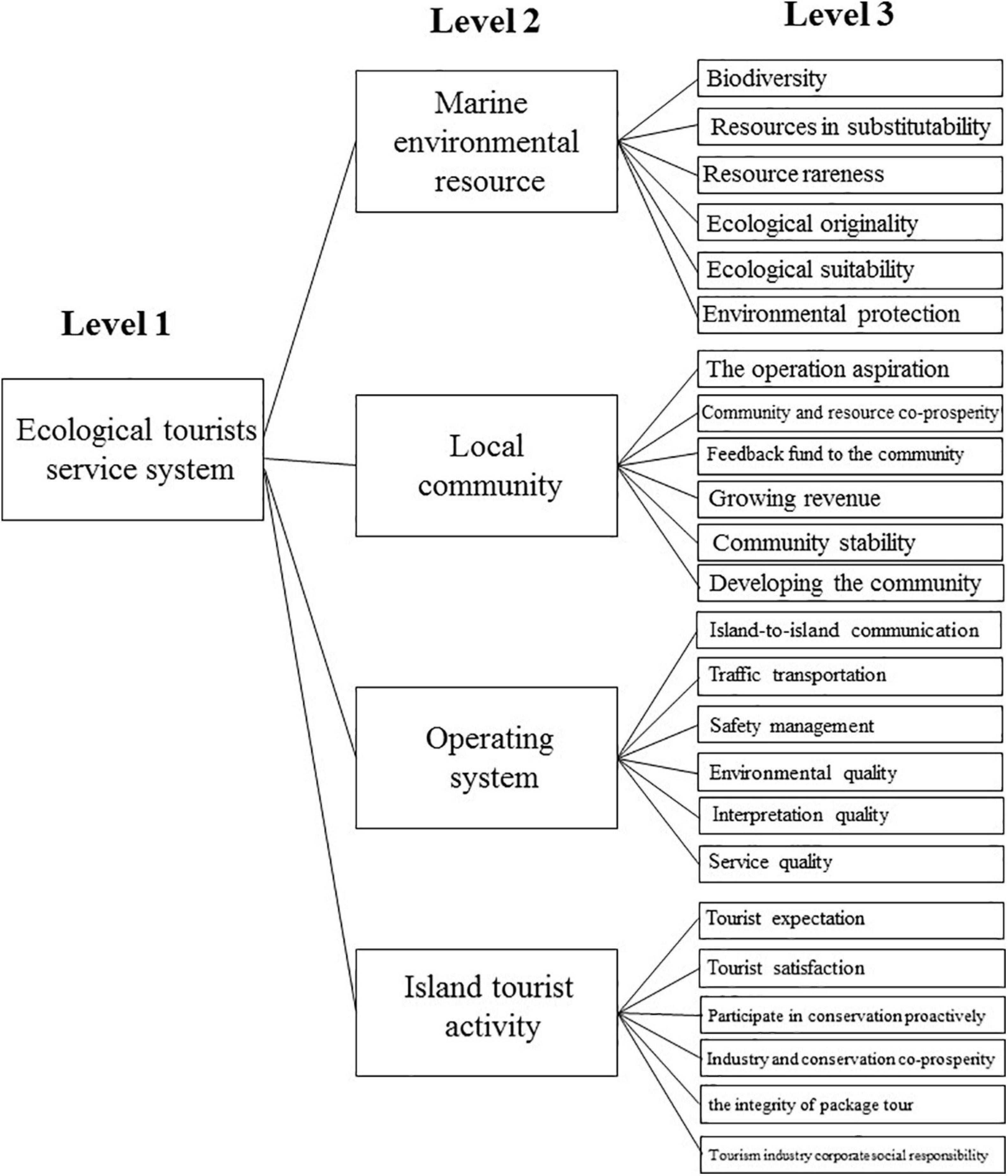
Figure 4. Indicators of the Penghu National Scenic Area ecological tourism service system framework.
In this study, the fuzzy analytical hierarchy process (Buckley, 1985) was used to find the fuzzy weights because it is easy to implement and is reliable. Essentially, FAHP is used to determine the weights of multiple criteria through pairwise comparison, the weights of importance of the criteria were first determined by the decision-maker and then sub-criteria were pulled using pairwise comparisons. The criteria/sub-criteria were first distinguished using a cumulative frequency distribution function, which involved the acceptable maximum [F1(x)] and minimum [F2(x)] of indicator identity, respectively. Then the values of the first quartile, median, and third quartile in F1(x) and F2(x) were calculated and named as (C1, M1, D1) and (C2, M2, D2), respectively. Finally, (C1, D1) and (C2, D2) were used to measure the importance of criteria, X∗. The linguistic scale and corresponding triangular fuzzy numbers (C1, M1, X∗) were identified to be “just equal” by (1, 1, 1), “equally important” by (1, 1, 3), “weakly important” by (1, 3, 5), “essentially important” by (3, 5, 7), “very important” by (5, 7, 9), and “absolutely important” by (7, 9, 9). The threshold value “S” needs to be 7 or higher for the individual indicator (Saaty, 1980; Buckley, 1985; Kaganski et al., 2018).
Survey Questionnaire
The questionnaires were divided into two categories: the expert questionnaire of the FDM for the construction of the indicators of the ecological tourism service system in the Penghu National Scenic Area; and the expert questionnaire of the hierarchical analysis method for the construction of the indicators of the ecological tourism service system in the Penghu National Scenic Area.
The expert questionnaire of the FDM was designed by reviewing the literature and developing the 4 dimensions and 24 indicators of the Penghu National Scenic Area ecotourism service system index. Each indicator had its own explanation, so that the respondents could understand the meaning and get the most appropriate opinions. The fuzzy theory was used to solve the group decision problem, and the selection of indicators was carried out to solve the problem of ambiguity in expert consensus.
The importance of the indicators was measured on a scale of 0–10, with higher scores indicating greater importance. Each factor was evaluated with three values: the “best value” of importance; and the “minimum” and “maximum” values of acceptable range.
The expert questionnaire of the hierarchical analysis method was designed based on the results of the first stage of the FDM. After removing the indicators that did not fit the criteria, the constructed and obtained indicators were used in the second round of the expert questionnaire design by the hierarchical analysis method. The terms marine environmental resource, local community, operating system, and island tourist activity were constructed by level 2. Twenty-four indicators were constructed on level 3.
Each indicator used a pairwise comparison approach, values from 1 to 9 were used as the evaluation scale to find the relative importance of each one. If the two indicators had the same importance, the participants assigned a value of 1 to this comparison, while a 9 represented the absolute importance of one criterion over the other (Saaty, 1994).
The first round expert questionnaire survey was conducted from April 12, 2016 to April 25, 2016 and the second round from April 27, 2016, to May 13, 2016. For the experts to understand the contents of the expert questionnaires, the authors went to Penghu for both rounds.
Results and Discussion
Indicator Selection
In the first stage of this article, an expert survey was conducted using the FDM to find the minimum, middle, and maximum values of the 24 indicators.
The experts ranked the indicators in order of importance as “safety management capability” (9.08), followed by “biodiversity” (8.83), “traffic and transportation” (8.67), “environmental quality” (8.67), “operation aspiration” (8.42), “service quality” (8.42), and “tourist satisfaction” (8.42).
The results showed that the average value of the 24 indicators ranged from 5.00 to 9.00 in this study. Saaty (1980); Buckley (1985), and Kaganski et al. (2018) indicated that threshold values must be over 7.00 for the indicator to be considered. From the results shown in Table 2, safety management and biodiversity were found to be “absolutely important” indicators with scores of 9.
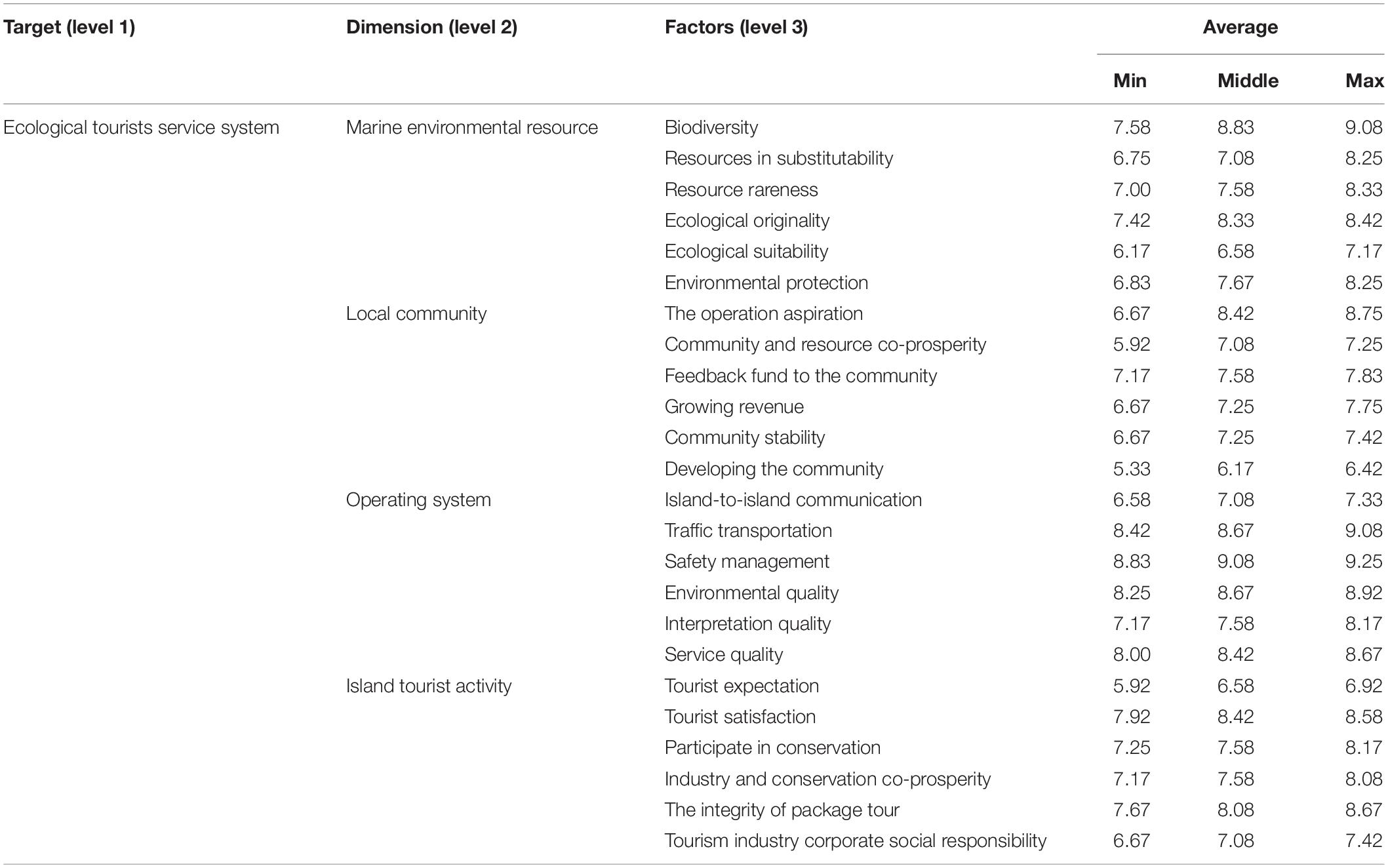
Table 2. The average value of ecotourism service system indicators in the Penghu National Scenic Area.
“Ecological suitability” (6.5), “developing the community” (5.0), and “tourist expectation” (6.5) were removed from the first round of the fuzzy Delphi survey because their value was below the threshold value. The Penghu National Scenic Area does not regulate recreational carrying capacity. However, this concept is very important to maintain marine environmental resources. There are 93 local community associations in the Penghu National Scenic Area. Wang-An has an advanced community association, but the tourism business does not provide technical assistance to the community (Chao and Chao, 2017). For tourist expectation, tourist expectations come from past experience, external communication, word-of-mouth communication, and destination image (Rodríguez-del-Bosque et al., 2009; Jusoh et al., 2015). Thus, there is a strong causal relationship between expectation and satisfaction. In other words, satisfaction is the difference between expectation and reality. However, the Penghu National Scenic Area does not yet have a clear ecotourism standard, and tourists’ expectation is mainly mass tourism; they do not have an impression of Penghu ecotourism. The majority of tourists participated in water activities such as snorkeling, swimming, and surfing. The tourists do not have clear expectations of ecotourism in Penghu. Therefore, satisfaction is an indicator of ecotourism in Penghu.
Results of Main Dimension
Fuzzy AHP has been used to determine the weights of each dimension concerning the goal and is presented in Figure 4. The results are shown in Table 3, where the most critical dimension is marine environmental resource (0.449) followed by operating system (0.253), local community (0.150), and island tourist activity (0.148).
The experts believed that marine environmental resources are the primary indicator for constructing the service system of the Penghu National Scenic Area. Rich marine resources are key to developing ecotourism in the Penghu National Scenic Area. Marine resources can be designed as experiential activities for tourists, resulting in tourism activities.
Second in rank is the “operation system” criterion, an important indicator in the construction of the ecological tourism service system. The ecotourism operating system needs to balance tourism activities, resources and the environment, and residents. It is important to plan the resources properly to maximize the benefits.
Ranking third is the “local community” criterion. The local community has the closest relationship with local natural resources and cultural resources, and is the core of ecotourism development. Community participation is decisive in the success or failure of ecotourism development, and can be more effective with community operation and participation.
Fourth in rank is the “island tourism activity” criterion, in which ecotourism is a nature-based tourism model that enables visitors to cherish and care for local resources through tourism planning.
Results of Factors
After removing ecological suitability, developing the community, and tourist expectation from the fuzzy Delphi survey, 21 indicators were kept for analysis. There are five, five, six, and five indicators respectively in the dimensions of marine environmental resource, local community, operating system, and island tourist activity (Table 4). The weight of these indicators was determined by Consistency Ratio (C.R.) and Consistency Index (C.I.) to ensure the reliability of the results.
Marine Environmental Resources
In this dimension, the result shows the weight of factors ranked as follows: biodiversity (0.266), environmental protection (0.208), resources rareness (0.193), ecological originality (0.181), and resources in substitutability (0.266). The C.R. and C.I. ratio values present 0.009 and 0.009, respectively, and the λmax value is 5.039. This indicates a consistent judgment and that the consistency of the display matrix is satisfactory (Table 5).
Local Community
The result shows the weight of indicators ranked as follows: operation aspiration (0.318), community and resource co-prosperity (0.287), feedback to the community (0.155), community stability (0.181), and growing revenue (0.105). The C.R. and C.I. ratio values are 0.017 and 0.015, respectively, and the λmax value is 5.068. This indicates a consistent overall judgment and satisfactory consistency of the display matrix (Table 6).
Operating System
The result shows the weight of indicators ranked as follows: environmental quality (0.254), safety management (0.227), traffic transportation (0.192), service quality (0.150), interpretation quality (0.117), and island-to-island communication (0.060). The C.R. and C.I. ratio values are 0.012 and 0.009, respectively, and the λmax value is 6.061. This indicates a consistent overall judgment and satisfactory consistency of the display matrix (Table 7).
Island Tourist Activity
For the island tourist activity perspective, the result shows the weight of indicators ranked as follows: industry and conservation co-prosperity (0.356), participate in conservation proactively (0.226), tourism comprehensive (0.183), tourism industry corporate social responsibility (0.146), and tourist satisfaction (0.089). The C.R. and C.I. ratio values are 0.005 and 0.005, respectively, and the λmax value is 6.061, it indicates a consistent overall judgment and satisfactory consistency of the display matrix (Table 8).
Results of Overall Indicators
In this study, the dimension and factors are combined to calculate the overall weights as results, in which the most essential factor is biodiversity (0.119), follow by environmental protection (0.093), resources rareness (0.087), ecological originality (0.081), resources in substitutability (0.068), environmental quality (0.064), safety management (0.057), industry and conservation co-prosperity (0.053), traffic transportation (0.049), and operation aspiration (0.048). All C.R. and C.I. ratio values achieved the decision value, indicating a consistent judgment and satisfactory consistency of the display matrix (Table 9).
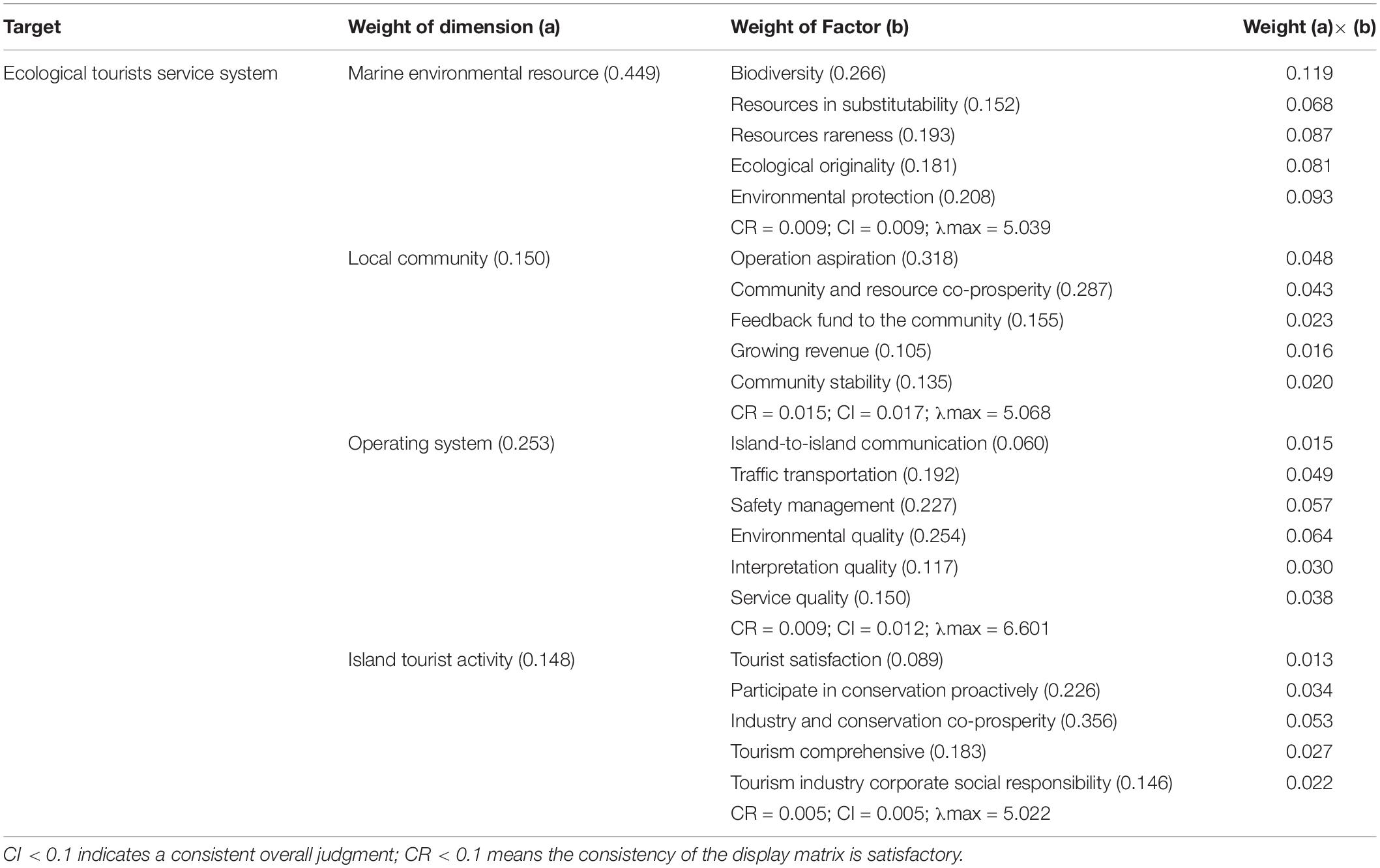
Table 9. The different level weight ratios of the ecosystem service system in the Penghu National Scenic Area.
Discussion
Importance Factors for Ecological Tourists Service System
Most of the experts considered safety management and biodiversity as critical indicators. Hauber and Zandbergen (1996) argued that when tourists select a destination, their safety needs to be ensured. Secure safety management can encourage more tourist activities and enhance ethical tourism (Chang and Wu, 2014). Ng et al. (2017) applied FAHP on Tioman Island in Malaysia and concluded that the most crucial factor was biodiversity.
The weights of the indicators for the tourist service system in Penghu were determined using the AHP with references from 18 experts. The relative weights of the three levels of 4 dimensions and 21 indicators were calculated. This article combined the weights between the second and third levels. The results show that biodiversity (0.119) had the highest weight among environmental protection (0.093), resources rareness (0.087), and ecological originality (0.081); resources in substitutability (0.068) was assessed in terms of marine environmental resource. Wardani et al. (2017), examining ecotourism in nature-based tourism, identified the critical success factor on the East Java Island in Indonesia as the marine environmental resource. Yu et al. (2015) argued that protecting marine resources has a positive impact on tourism. Chao and Chao (2017) provided residents with the need to protect the local environment and design more ecotourism activities to gain more revenue.
The lowest weight indicators were tourist satisfaction (0.013), island-to-island communication (0.015), growing revenue to the community (0.016), stabilizing the community (0.020), and tourism industry CSR (0.022). Chao and Chao (2017) investigated the resident and visitor perceptions of the Wang-An Islands (green sea turtle), and pointed out the gap between visitors and residents; the resident could not provide tourist products or services to satisfy the visitors. For island-to-island communication, island resources can be shared with other islands, and each island can partner with other islands when setting multiple-day tours or designing long-term travel options (Tuan, 2016). To grow revenue and to stabilize the community, United Nations World Tourism Organization (2015) created the SDG criteria to measure the effect of sustainable tourism on the economic growth of the local community. Kontogeorgopoulos and Chulikavit (2010) pointed out that ecotourism can provide jobs and generate revenue for the community. Chao and Chao (2017) suggested that residents need to understand their environmental resources. Ng et al.’s (2017) research on Tioman Island in Malaysia argued that tourism CSR improves tourists’ perception of environmental protection.
For the local community, the highest weight indicators were operational aspiration (0.048) and community and resource co-prosperity (0.043). Kutay (1991) illustrated that operational aspiration enhanced the community, and resource co-prosperity could encourage residents to protect and upgrade environmental quality, revitalize old structures, and conserve their local culture (United Nations World Tourism Organization, 2015). For the operating system, environmental quality (0.064) ranked first, above safety management (0.057), and traffic transportation (0.049). Harry (2017) pointed out that tourists prefer a high quality and clean environment. Chiu et al. (2014) investigated ecotourism and pointed out that good environmental quality leads to ecotourism; thus, it needs to maintain high environmental quality (Chen, 2015). Lin (2008) pointed out that excellent traffic transportation is a critical factor in ecotourism, and for island tourist activities, industry, and conservation co-prosperity (0.053). Chao and Chao (2017) identified that resident participation is a crucially important factor; upgrading the participation aspiration of residents can improve the economy.
Managerial Implications
Emphasis on the importance of biodiversity to improve the quality of the marine resource
For the sustainable development of island ecotourism, biodiversity is essential (Hunt and Vargas, 2018). Bhuiyan et al. (2015) argued that the resource has a positive influence on community and tourism in Kenyir Island. Chang and Wu (2014) argued that biodiversity is an essential factor for coastal ecotourism, when they applied the FDM. To address the conservation of marine resources, it is very important for people to maintain friendly ecotourism traveling and reduce the conflict of ecotourism. Therefore, tourists need to display actually protective environmental behavior, such as smaller-scale traveling and carrying toiletries by themselves, to deeply experience local environmental activities (Chao and Chao, 2017). At the same time, stakeholders and residents need to improve their local environmental protection awareness and knowledge, and then share it with the tourists.
Promote the participation of stakeholders and local communities to increase ecotourism
Many benefits are realized when the local community, stakeholders, and tourists interact in the course of ecotourism activity, interpretation, and sightseeing. Therefore, the community’s willingness to participate has a considerable influence on ecotourism. The community can integrate tourism development with community development and environmental protection, protect the resources, and promote the economic development of the community at the same time (Bhuiyan et al., 2015; Hayes et al., 2015; Chao and Chao, 2017).
Construct the safety management system to sustain ecotourism development
Ecotourism is a relationship between the local community and tourists. To ensure the safety of tourists, Wang (2015) constructed management indicators in Penghu Island that covered traffic, recreation, accommodation, sanitation, and shopping. Thus, the local community need to consider natural safety to prevent climate change; biological safety for protection against toxic plants and dangerous animals; avoidance of unplanned travel near steep slopes, narrow roads, and cliffs; and educating residents and tourists about safety.
Keep environmental conservation in the guideline of tourist activity
The sustainable development of ecotourism relies on rich natural resources. Residents need to have an environmental concern and awareness to find a balance between tourists and the surroundings. Hayes et al. (2015) argued that the resources can be used to develop ecotourism, which can bring economic benefits for residents and for the environment (Chao and Chao, 2017). More residents are building ecological, physical, facility, and social capacity to benefit tourists (Shelby and Heberlein, 1984) and protect the environment.
Encourage local communities to promote ecotourism
Ecotourism development attaches great importance to the participation of local communities in planning and management. Local communities are the key to protection, economic benefits, and social benefits (Kutay, 1991; Chao and Chao, 2017). The government should encourage and establish a business standard, protecting contracts and cooperation that can support sustainable ecotourism development in local communities, and also respect nature and the residents.
Improve tourist satisfaction
The local residents preserve the island environment, develop ecological experience activities, and pay attention to service quality. Island tourists’ satisfaction and revisit willingness comes from the factors: island natural beauty, local history and culture, hospitality, safety, facilities, and services, etc. (Truong and King, 2009). Moon and Han (2018) used Jeju Island to show that environmental resources and accessibility have a positive impact on tourists’ experience and satisfaction.
Policy Implications
The government needs to support the local resource inventory and provide guidelines for marine resource protection
The government should be able to support the local resource inventory, divide ecotourism into core protected areas, and buffer recreational areas and intensive recreation areas. To reach the three-level environmental requirements, the environmental impact of visitor activities should be reduced, a high-quality tourism experience should be provided, and a damaged natural ecological environment should be protected and restored. The government should consider maintenance, restraint, binding, participation, and active policy support to implement environmental monitoring mechanisms. To enhance marine ecological protection, destruction of biodiversity should be avoided. Wardani et al. (2017) argued that the government needs to guide stakeholders in managing their marine resources. Increasing marine biodiversity and establishing measures to protect marine resources can help the industry to maximize its economic, social, and environmental benefits in developing sustainable ecotourism.
The government constructs a normative plan for the ecotourism promotion service system
The government should formulate a clear and specific management mechanism for ecotourism development, provide guidance for operators, and monitor progress in the environment, society, economy, and culture to maximize the benefits.
The government should prioritize environmental quality management practices to reduce marine waste. Provision should be made for accommodation and catering, water and power supply, telecommunications, and public toilets. Penghu ecotourism has rich natural resources but is more unsafe than other scenic spots; therefore, ecotourism for safety management is a key responsibility.
The government needs to improve the infrastructure in safety management and transportation
The government should take the primary core resources of ecotourism as a starting point for creating a complete safety management system that includes integrated prevention, rescue, and after-care work. The transportation capacity of the Penghu National Scenic Area is limited, the busses run infrequently, and the information for maritime transportation is difficult to obtain. Many visitors must take private transportation to the island. This is not in line with international standards. The government should provide free-shipping classes to provide residents and tourists with a wide choice and make information on transportation services more easily available for tourists. In short, these factors provide the elements for successful ecotourism management. Yusof et al. (2014) applied the service quality models to ecotourism in Malaysia and argued for the need to refine the service system model.
Conclusion
This study has several important theoretical implications. First, this study applying the fuzzy AHP method to establish the indicators for the tourist service system of the Penghu National Scenic Area based on the island ecotourism perspective. Second, we reviewed articles about island tourism, ecotourism, and tourist service systems, and tried to find dimensions such as marine environmental resource, local community, island tourist activity, and operating systems. The key factors of island ecotourism are marine environmental resources, notably biodiversity. Protecting marine environmental resources could develop island ecotourism. Third, we identified the model to develop island ecotourism in the early steps of the decisional process guide. In this case, the Penghu National Scenic Area has three ecotourism systems and many resources to attract tourists. This ecotourism indicator framework can be applied to other islands or protected areas, especially in popular tourist destinations, such as Bali Island, Jeju Island, and Tioman Island.
This study still has some limitations, which need to be considered in future research. This study was undertaken in the Penghu National Scenic Area. It is recommended to generate other studies on other islands. In the study, only 18 experts were consulted; the inclusion of more experts would produce significant results.
This study used fuzzy AHP to establish island ecological indicators in the Penghu National Scenic Area. In future research studies, fuzzy-based MCDM methods such as ANP, DEA, ELECTRE, TOPSIS, and VIKOR can be applied to similar problems. The results could be compared to those of this study to determine an island’s ecological indicators.
Data Availability Statement
The original contributions presented in the study are included in the article/supplementary material, further inquiries can be directed to the corresponding author/s.
Ethics Statement
Ethical review and approval was not required for this study with human participants, in accordance with the local legislation and institutional requirements.
Author Contributions
CH contributed to the data analysis and drafting of the manuscript. CK contributed to significant revisions of the manuscript. CT contributed to the concept construction design of the manuscript.
Conflict of Interest
The authors declare that the research was conducted in the absence of any commercial or financial relationships that could be construed as a potential conflict of interest.
Publisher’s Note
All claims expressed in this article are solely those of the authors and do not necessarily represent those of their affiliated organizations, or those of the publisher, the editors and the reviewers. Any product that may be evaluated in this article, or claim that may be made by its manufacturer, is not guaranteed or endorsed by the publisher.
References
Agyeiwaah, E., McKercher, B., and Suntikul, W. (2017). Identifying core indicators of sustainable tourism: a path forward? Tour. Manag. Perspect. 24, 26–33. doi: 10.1016/j.tmp.2017.07.005
Baral, N. (2015). Assessing the temporal stability of the ecotourism evaluation scale: testing the role and value of replication studies as a reliable management tool. J. Sustain. Tour. 23, 280–293. doi: 10.1080/09669582.2014.953541
Becken, S., and Khazai, B. (2017). “Resilience, tourism and disaster,” in Tourism and Resilience, ed. R. W. Butler (Oxfordshire: CAB), 96–104. doi: 10.1079/9781780648330.0096
Beskese, A., Demir, H., Ozcan, K., and Okten, H. (2015). Landfill site selection using fuzzy AHP and fuzzy TOPSIS: a case study for Istanbul. Environ. Earth Sci. 73, 3513–3521. doi: 10.1007/s12665-014-3635-5
Bhuiyan, M. A. H., Siwar, C., and Ismail, S. M. (2016). Sustainability measurement for ecotourism destination in Malaysia: a study on Lake Kenyir, Terengganu. Soc. Ind. Res. 128, 1029–1045. doi: 10.1007/s11205-015-1068-5
Bhuiyan, M. A. H., Chamhuri, S., and Ismail, S. M. (2015). Sustainability measurement for ecotourism destination in Malaysia: a study on Lake Kenyir, Terengganu. Soc. Indic. Res. 128, 1029–1045. doi: 10.1007/s11205-015-1068-5
Blancas, F. J., Lozano-Oyola, M., and González, M. (2015). A European sustainable tourism labels proposal using a composite indicator. Environ. Impact Assess. Rev. 54, 39–54. doi: 10.1016/j.eiar.2015.05.001
Brody, S. D. (2016). Ecosystem Planning in Florida: Solving Regional Problems Through Local Decision-Making. Milton Park: Routledge. doi: 10.4324/9781315578750
Buckley, J. J. (1985). Ranking alternatives using fuzzy numbers. Fuzzy Sets Syst. 15, 21–31. doi: 10.1016/0165-0114(85)90013-2
Butler, R. W. (1999). Sustainable tourism: a state-of-the-art review. Tour. Geogr. 1, 7–25. doi: 10.1080/14616689908721291
Buultjens, A. H., Lam, M. M. C., Ballard, S., Monk, I. R., Mahony, A. A., Grabsch, E. A., et al. (2017). Evolutionary origins of the emergent ST796 clone of vancomycin resistant Enterococcus faecium. PeerJ 5:e2916. doi: 10.7717/peerj.2916
Carlsen, J., and Butler, R. (2011). Island Tourism: Towards a Sustainable Perspective. Oxfordshire: CAB. doi: 10.1079/9781845936792.0000
Castro-Pardo, M., Pérez-Rodríguez, F., Martín, J., and Azevedo, J. (2019). Modelling stakeholders’ preferences to pinpoint conflicts in the planning of transboundary protected areas. Land Use Policy 89:104233. doi: 10.1016/j.landusepol.2019.104233
Chang, Y. C., and Wu, C. H. (2014). Evaluation indicators for coastal ecotourism based on Fuzzy Delphi method. J. Taiwan Agric. Eng. 60, 10–20.
Chao, Y. L., and Chao, S. Y. (2017). Resident and visitor perceptions of island tourism: green sea turtle ecotourism in Penghu Archipelago. Taiwan Island Stud. J. 12, 213–228. doi: 10.24043/isj.27
Cheer, J. M., Belhassen, Y., and Joanna, K. (2017). The search for spirituality in tourism: toward a conceptual framework for spiritual tourism. Tour. Manage. Perspect. 24, 252–256. doi: 10.1016/j.tmp.2017.07.018
Chen, H. S. (2015). The establishment and application of environment sustainability evaluation indicators for ecotourism environments. Sustainability 7, 4727–4746. doi: 10.3390/su7044727
Cheng, T. M., Wu, H. C., and Huang, L. M. (2013). The influence of place attachment on the relationship between destination attractiveness and environmentally responsible behavior for island tourism in Penghu, Taiwan. J. Sustain. Tour. 21, 1166–1187. doi: 10.1080/09669582.2012.750329
Chiu, Y. T., Lee, W. I., and Chen, T. H. (2014). Environmentally responsible behavior in ecotourism: antecedents and implications. Tour. Manage. 40, 321–329. doi: 10.1016/j.tourman.2013.06.013
Cullen-Unsworth, L. C., Nordlund, L. M., Paddock, J., Baker, S., McKenzie, L. J., and Unsworth, R. K. (2014). Seagrass meadows globally as a coupled social-ecological system: implications for human wellbeing. Mar. Pollut. Bull. 83, 387–397. doi: 10.1016/j.marpolbul.2013.06.001
Dalkey, N., and Helmer, O. (1963). An experimental application of the Delphi method to the use of experts. Manage. Sci. 9, 458–467. doi: 10.1287/mnsc.9.3.458
Das, M., and Chatterjee, B. (2015). Ecotourism and empowerment: a case analysis of Bhitarkanika Wildlife sanctuary, Odisha, India. IIM Kozhikode Soc. Manage. Rev. 4, 136–145. doi: 10.1177/2277975215613175
Delbecq, A. L., Van de Ven, A. H., and Gustagson, D. H. (1975). Group Techniques for Program Planning : A Guide to Nominal Group and Delphi Process. Glenview, IL: Scott, Foreman.
Douglas, C. H. (2006). Small island states and territories: sustainable development issues and strategies – challenges for changing islands in a changing world. Sust. Dev. 14, 75–80. doi: 10.1002/sd.297
Fernández Martínez, P., de Castro-Pardo, M., Barroso, V. M., and Azevedo, J. C. (2020). Assessing sustainable rural development based on ecosystem services vulnerability. Land 9:222. doi: 10.3390/land9070222
Gallopín, G. C. (1996). Environmental and sustainability indicators and the concept of situational indicators. A systems approach. Environ. Model. Assess. 1, 101–117. doi: 10.1007/BF01874899
Gezon, L. L. (2014). Who wins and who loses? Unpacking the local people concept in ecotourism: a longitudinal study of community equity in Ankarana, Madagascar. J. Sustain. Tour. 22, 821–838. doi: 10.1080/09669582.2013.847942
Glynn, W. J., and Barnes, J. B. (1995). Understanding Services Management. Ireland: John Wiley & Sons, Inc.
Gogus, O., and Boucher, T. (1998). Strong transitivity, rationality and weak monotonicity in fuzzy pairwise comparisons. Fuzzy Sets Syst. 94, 133–144. doi: 10.1016/S0165-0114(96)00184-4
Gunter, U., Ceddia, M. G., and Tröster, B. (2017). International ecotourism and economic development in Central America and the Caribbean. J. Sustain. Tour. 25, 43–60. doi: 10.1080/09669582.2016.1173043
Hall, C. M. (2012). Island, islandness, vulnerability, and resilience. Tour. Recreation Res. 37, 177–181. doi: 10.1080/02508281.2012.11081703
Hall, M. C. (2010). Island destinations: a natural laboratory for tourism: introduction. Asia Pacific J. Tour. Res. 15, 245–249. doi: 10.1080/10941665.2010.503613
Harry, S. (2017). Influence customer relationship marketing and customer value towards banking consumer trust. Jom Fisip 4.
Hauber, A. R., and Zandbergen, A. G. A. (1996). Foreign visitors as targets of crime in the Netherlands: perceptions and actual victimization over the years 1989, 1990, and 1993. Secur. J. 7, 211–218. doi: 10.1016/0955-1662(96)00174-9
Hayes, M. C., Peterson, M. N., Justa, L. H. K., and Langerhans, R. B. (2015). Tourism-related drivers of support for protection of fisheries resources on Andros Island, The Bahamas. Ocean Coast. Manag. 106, 118–123. doi: 10.1016/j.ocecoaman.2015.01.007
Hillery, M., Nancarrow, B., Griffin, G., and Syme, G. (2001). Tourist perception of environmental impact. Ann. Tour. Res. 28, 853–867. doi: 10.1016/S0160-7383(01)00004-4
Honey, M. (2008). Ecotourism and Sustainable Development: Who Owns Paradise?. Washington, DC: Island Press.
Hornoiu, R. I., Minciu, R., and Hociung, I. G. (2009). “Methods and indicators regarding the tourism assessment impact in protected areas,” in Proccedings of the (University of Messina & Bucharest Academy of Economic Studies) The 2009 International Conference on Tourism, Messina, Italy 22-25 April, Messina, (Messina).
Hsieh, C. M., Park, S. H., and Huh, C. (2016). “A comparison model of residents’ and tourists’ attitudes toward sustainable tourism development: a case of Penghu island in Taiwan,” in Proceedings of the ttra Annual International Conference Tourism Travel and Research Association: Advancing Tourism Research Globally, (Victoria, BC), 11.
Hu, C. C. (2009). The relationships among service quality, service value, leisure experiences and tourist satisfaction on behavioral intention-a case study of 2008 Penghu Seafood Festival. J. Island Tour. Res. 2, 46–74. doi: 10.29859/JITR.200909.0004
Hung, C. M. (2004) The Research on Residents” Perception and Development Attitude Toward Ecotourism in Penghu Area Master Thesis. Taiwan.
Hughes, G. (1995). The cultural construction of sustainable tourism. Tour. Manag. 16, 49–59. doi: 10.1016/0261-5177(94)00007-W
Hunt, C., and Vargas, E. (2018). Turtles, tacos, and tourists: protected areas and marine turtle conservation in Costa Rica. J. Park Recreation Adm. 36, 101–114. doi: 10.18666/JPRA-2018-V36-I3-8820
Hunt, C. A., Durham, W. H., Driscoll, L., and Honey, M. (2015). Can ecotourism deliver real economic, social, and environmental benefits? A study of the Osa Peninsula, Costa Rica. J. Sustain. Tour. 23, 339–357. doi: 10.1080/09669582.2014.965176
Jusoh, J., Abd hamid, N., Ulyani, N., and Najib, M. (2015). The expectation and satisfaction of the first time and return tourists toward the heritage attractions in Melaka. Pertanika J. Soc. Sci. Hum. 23, 195–208.
Kaganski, S., Majak, J., and Karjust, K. (2018). Fuzzy AHP as a tool for prioritization of key performance indicators. Procedia CIRP 72, 1227–1232. doi: 10.1016/j.procir.2018.03.097
Kim, Y., and Chung, E. (2013). Fuzzy VIKOR approach for assessing the vulnerability of the water supply to climate change and variability in South Korea. Appl. Math. Model 37, 9419–9430.
Kontogeorgopoulos, N., and Chulikavit, K. (2010). Supply-side perspectives on ecotourism in Northerland Thailand. Int. J. Tour. Res. 12, 627–647. doi: 10.1002/jtr.785
Kuo, N. W., and Chen, P. H. (2009). Quantifying energy use, carbon dioxide emission, and other environmental loads from island tourism based on a life cycle assessment approach. J. Clean. Prod. 17, 1324–1330. doi: 10.1016/j.jclepro.2009.04.012
Kurniawan, F., Adrianto, L., Bengen, D. G., and Prasetyo, L. B. (2017). Biocapacity in the Gili Matra region: a spatial assessment of the carrying capacity of small islands. Omni Akuatika 13, 39–47. doi: 10.20884/1.oa.2017.13.2.228
Kurniawan, F., Adrianto, L., Bengen, D., and Prasetyo, L. (2019). The social-ecological status of small islands: an evaluation of island tourism destination management in Indonesia. Tour. Manag. Perspect. 31, 136–144. doi: 10.1016/j.tmp.2019.04.004
Kutay, K. (1991). “Cahuita national park, Costa Rica:a case study in living cultures and national park management,” in Resident People and National Parks: Social Dilemmas and Strategies in International, eds P. C. West and S. R. Brechin (Tucson: University of Arizona Press).
Layke, C. (2009). “Measuring Nature’s benefits: a preliminary roadmap for improving ecosystem service indicators,” in Paper Present at WRI Working Paper, (Washington, DC: World Resources Institute).
Lee, T. H., and Hsieh, H. P. (2016). Indicators of sustainable tourism: a case study from a Taiwan’s wetland. Ecol. Indic. 67, 779–787. doi: 10.1016/j.ecolind.2016.03.023
Liang, C. H., and Tsai, C. Y. (2008). A study of relationships among tourist motivation, experience, satisfaction and revisiting intention of Penghu ecotourism. J. Sport Recreation Res. 2, 94–109.
Lin, F. L. (2008). The Tour Planning for the Sustainable Ecotourism in the Green island of Taiwan, Master Thesis, Taiwan. Taipei: National Taipei University.
Lin, H. C. (2002) Study on the Marketing Strategy of Penghu Tourism Business Development Policy Master Thesis. Taiwan.
Linstone, H. A. (1978). “The delphi technique,” in Handbook of Futures Research, ed. J. Fowless (London: Greenwood Press), 273–300.
Liu, S., and Li, W. Y. (2020). Ecotourism research progress: a bibliometric analysis during 1990–2016. SAGE Open 10, 1–12. doi: 10.1177/2158244020924052
Lovelock, B., Lovelock, K., and Normann, Ø. (2010). The big catch: Negotiating the transition from commercial fisher to tourism entrepreneur in island environments. Asia Pac. J. Tour. Res. 15, 267–283. doi: 10.1080/10941665.2010.503616
Luthe, T., and Wyss, R. (2016). Resilience to climate change in a cross-scale tourism governance context: a combined quantitative-qualitative network analysis. Ecol. Soc. 21:27. doi: 10.5751/ES-08234-210127
Mai, T., and Smith, C. (2015). Addressing the threats to tourism sustainability using systems thinking: a case study of Cat Ba Island, Vietnam. J. Sustain. Tour. 23, 1504–1528. doi: 10.1080/09669582.2015.1045514
Mai, T., and Smith, C. (2018). Scenario-based planning for tourism development using system dynamic modelling: a case study of Cat Ba Island, Vietnam biocultural diversity. Land Use Policy 72, 57–64.
Marsh, H. W. (1993). The effects of participation in sport during the last two years of high school. Sociol. Sport J. 10, 18–43. doi: 10.1123/ssj.10.1.18
Mathis, A., and Rose, J. (2016). Balancing tourism, conservation, and development: a political ecology of ecotourism on the Galapagos Islands. J. Ecotourism 15, 64–77. doi: 10.1080/14724049.2015.1131283
McKercher, B. (1993). The unrecognized threat to tourism: can tourism survive sustainability. Tour. Manag. 14, 131–136. doi: 10.1016/0261-5177(93)90046-N
Miller, M. L., and Kaae, B. C. (1993). Coastal and marine ecotourism: a formula for sustainable development? Trends 30, 35–41.
Moon, H., and Han, H. (2018). Destination attributes influencing Chinese travelers’ perceptions of experience quality and intentions for island tourism: a case of Jeju Island. Tour. Manag. Perspect. 28, 71–82. doi: 10.1016/j.tmp.2018.08.002
Ng, S. I., Chia, K. W., Ho, J. A., and Ramachandran, S. (2017). Seeking tourism sustainability – A case study of Tioman Island, Malaysia. Tour. Manag. 58, 101–107. doi: 10.1016/j.tourman.2016.10.007
Ni, C. C. (2000). The analysis on tourists’ decision-making to island tours-a case study of Penghu Islands. J. Outdoor Recreat. Study 13, 27–49. doi: 10.6130/JORS.2000.13(4)2
Ocampo, L., Ebisa, J. A., Ombe, J., and Geen Escoto, M. (2018). Sustainable ecotourism indicators with the Fuzzy Delphi method – A Philippine perspective. Ecol. Indic. 93, 874–888. doi: 10.1016/j.ecolind.2018.05.060
Penghu National Scenic Area Administration (2018). Introduction to the Penghu National Scenic Area. Available online at: https://www.penghu-nsa.gov.tw/AboutUs
Pennington-Gray, L., Reisinger, Y., Kim, J. E., and Thapa, B. (2005). Do US tour operators’ brochures educate the tourist on culturally responsible behaviours? A case study for Kenya. J. Vacation Market. 11, 265–284. doi: 10.1177/1356766705055719
Phillips, W. N. (2015). Tourism threats to coral reef resilience at koh sak, pattaya bay. Environ. Natural Resour. J. 13, 47–60.
Regmi, K. D., and Walter, P. (2017). Modernisation theory, ecotourism policy, and sustainable development for poor countries of the global South: perspectives from Nepal. Int. J. Sustain. Dev. World Ecol. 24, 1–14. doi: 10.1080/13504509.2016.1147502
Rodríguez-del-Bosque, I., Gutiérrez, H., Agudo, J., and Garcia-De los Salmones, M. (2009). A framework for tourist expectations. Int. J. Cult. Tour. Hosp. Res. 3, 139–147. doi: 10.1108/17506180910962140
Ross, S., and Wall, G. (1999). Evaluating ecotourism: the case of North Sulawesi, Indonesia. Tour. Manag. 20, 673–682. doi: 10.1016/S0261-5177(99)00040-0
Russell, R., and Faulkner, B. (2004). Entrepreneurship, chaos and the tourism area lifecycle. Ann. Tour. Res. 31, 556–579. doi: 10.1016/j.annals.2004.01.008
Saaty, T. L. (1974). Measuring the fuzziness of Sets. J. Cybern. 4, 53–61. doi: 10.1080/01969727408546075
Saaty, T. L. (1980). The Analytic Hierarchy Process. New York, NY: McGraw-Hill. doi: 10.21236/ADA214804
Saaty, T. L. (1994). How to make a decision: the analytic hierarchy process. Interfaces 24, 19–43. doi: 10.1287/inte.24.6.19
Sackman, H. (1974). Delphi Critique: Expert Opinion, Forecasting, and Group Process. Lexington, MA: Lexington Books.
Sander, B. (2012). The importance of education in ecotourism ventures: lessons from Rara Avis ecolodge, Costa Rica’. Int. J. Sustain. Soc. 4, 389–404. doi: 10.1504/IJSSOC.2012.049408
San-Jose, L., and Retolaza, J. (2016). Is the Delphi method valid for business ethics? A survey analysis. Eur. J. Futures Res. 4, 1–15. doi: 10.1007/s40309-016-0109-x
Sharpley, R. (2015). Island tourism or tourism on islands? Tour. Recreation Res. 37, 167–172. doi: 10.1080/02508281.2012.11081701
Shelby, B., and Heberlein, T. A. (1984). A conceptual framework for carrying capacity determination. Leisure Sci. 6, 433–451. doi: 10.1080/01490408409513047
Shelly, R., and Wall, G. (2001). Evaluating ecotourism: the case of North Sulawesi. Annu. Tour. Res. 23, 122–132.
Stem, C. J., Lassoie, J. P., Lee, D. R., and Deshler, D. J. (2003). How ‘Eco’ is Ecotourism? A comparative case study of ecotourism in Costa Rica. J. Sustain. Tour. 11, 322–347. doi: 10.1080/09669580308667210
Sundra, I. K. (2011). Quality of coastal waters in Badung regency which is used as a tourism activity. Bumi Lestari 11, 227–233.
Taiwanese Tourism Bureau Republic of China (2018). Yearly Report of Tourism Statistics. Taipei: Taiwanese Tourism Bureau Republic of China.
Thompson, B. S., Gillen, J., and Friess, D. A. (2018). Challenging the principles of ecotourism: insights from entrepreneurs on environmental and economic sustainability in Langkawi, Malaysia. J. Sustain. Tour. 26, 257–276. doi: 10.1080/09669582.2017.1343338
Truong, T.-H., and King, B. (2009). An evaluation of satisfaction levels among Chinese tourists in Vietnam. Int. J. Sustain. Tour. 11, 521–535. doi: 10.1002/jtr.726
Tsaur, S. H., Lin, Y. C., and Lin, J. H. (2006). Evaluating ecotourism’s sustainability from the integrated perspective of resource, community and tourism. Tour. Manag. 27, 640–653. doi: 10.1016/j.tourman.2005.02.006
Tuan, C. L. (2016). Recreational Agriculture: An Experience Respective (3rd). Taipei: Farseeing Published.
Tuan, C. L. (2019). Recreational Farm Management- Agribusiness Perspective. Taipei: Farseeing Published.
United Nations World Tourism Organization (2014). Tourism in Small Island Developing States (SIDS): Building a more sustainable future for the people of islands. Madrid: World Tourism Organization.
United Nations World Tourism Organization (2015). UNWTO Tourism Highlights 2015 Edition. Madrid: World Tourism Organization.
United Nations World Tourism Organization (2017). Tourism and the Sustainable Development Goals. Madrid: World Tourism Organization.
United Nations World Tourism Organization (UNWTO) (2018). Tourism in the 2030 Agenda. Madrid: World Tourism Organization.
Wang, M. Q. (2015). Research of Tourism Safety Management Strategies on Penghu County - Application of Analytic Hierarchy Process (AHP), Master Thesis. Kaohsiung: National Sun Yat-sen University.
Wang, S. H., Lee, M. T., Château, P. A., and Chang, Y. C. (2016). Performance indicator framework for evaluation of sustainable tourism in the Taiwan Coastal Zone. Sustainability 8:652. doi: 10.3390/su8070652
Wardani, M. P., Fahrudin, A., and Yulianda, F. (2017). Analysis of successful strategy to develop sustainable marine ecotourism in Gili Bawean Island, Gresik, East Java. Earth Environ. Sci. 89, 1–9. doi: 10.1088/1755-1315/89/1/012036
Weaver, D. B., and Lawton, L. J. (2007). Twenty years on: the state of contemporary ecotourism research. Tour. Manag. 28, 1168–1179. doi: 10.1016/j.tourman.2007.03.004
Weaver, D. B. (2001). Ecotourism as mass tourism: contradiction or reality? Cornell Hotel Restaur. Adm. Q. 42, 104–112. doi: 10.1016/S0010-8804(01)80022-7
Weng, L. S. (2014). Development of Taiwan forest recreation area operation service system. Taiwan For. J. 40, 69–76.
World Commission on Environment and Development (1987). Our Common Future. New York NY: World Commission on Environment and Development.
Wu, C. C., and Tsai, H. M. (2015). A capital-based framework for assessing coastal and marine social-ecological dynamics and natural resource management: a case study of Penghu archipelago. J. Mar. Island Cult. 3, 60–80. doi: 10.1016/j.imic.2014.10.001
Wu, H. C., Huang, C. T., and Hung, C. M. (2005). Residents’ perceptions of ecotourism and attitudes toward its development in the Pescadores. Taiwan J.f Outdoor Recreation Study 18, 1–30.
Wu, P. L. (2007) Discussing the Local Sustainability from the Viewpoint of the Growing Guesthouse Industry in Penghu, Master Thesis. Taiwan
Xue, J. J. (2002). A Study on the Segmentation of Penghu Tourism Market by Using Vacation Lifestyle Master Thesis. Taiwan.
Yılmaz, H., and Surat, H. (2015). Analitik hiyerarşi süreci kullanılarak en uygun ekoturizm etkinliğinin belirlenmesi. Turkish J. For. 16, 164–176. doi: 10.18182/tjf.86170
Yu, S. L., Chu, Y. C., and Tsai, C. W. (2015). Stone weirs in Penghu and adaption to tourism development. J. Ecol. Environ. 38, 257–262. doi: 10.5141/ecoenv.2015.026
Yusof, N., Abd Rahman, F., Che Jamil, M. F., and Mohammad, I. (2014). Measuring the quality of ecotourism services: case study–based model validation. SAGE 4, 1–9. doi: 10.1177/2158244014538270
Zartha Sossa, J. W., Álvarez Jaramillo, J., and Orozco Mendoza, G. L. (2019). Barriers to sustainability for small and medium enterprises in the framework of sustainable development—Literature review. Bus. Strategy Environ. 28, 512–524. doi: 10.1002/bse.2261
Appendix
Keywords: ecotourism, sustainability, island tourism, Penghu National Scenic Area, tourist service system, ecotourism indicator
Citation: Hsiao CY, Kuo CM and Tuan CL (2021) Island Ecological Tourism: Constructing Indicators of the Tourist Service System in the Penghu National Scenic Area. Front. Ecol. Evol. 9:708344. doi: 10.3389/fevo.2021.708344
Received: 18 May 2021; Accepted: 07 September 2021;
Published: 15 October 2021.
Edited by:
Alvaro Soutullo, Universidad de la República, UruguayReviewed by:
Gualter Couto, Universidade dos Açores, PortugalHarsuko Riniwati, University of Brawijaya, Indonesia
Mónica De Castro-Pardo, Complutense University of Madrid, Spain
Copyright © 2021 Hsiao, Kuo and Tuan. This is an open-access article distributed under the terms of the Creative Commons Attribution License (CC BY). The use, distribution or reproduction in other forums is permitted, provided the original author(s) and the copyright owner(s) are credited and that the original publication in this journal is cited, in accordance with accepted academic practice. No use, distribution or reproduction is permitted which does not comply with these terms.
*Correspondence: Chih Yu Hsiao, c2t5Ymx1ZXNlYTIwMDRAaG90bWFpbC5jb20=
 Chih Yu Hsiao
Chih Yu Hsiao Chun Min Kuo
Chun Min Kuo Chao Lin Tuan3
Chao Lin Tuan3